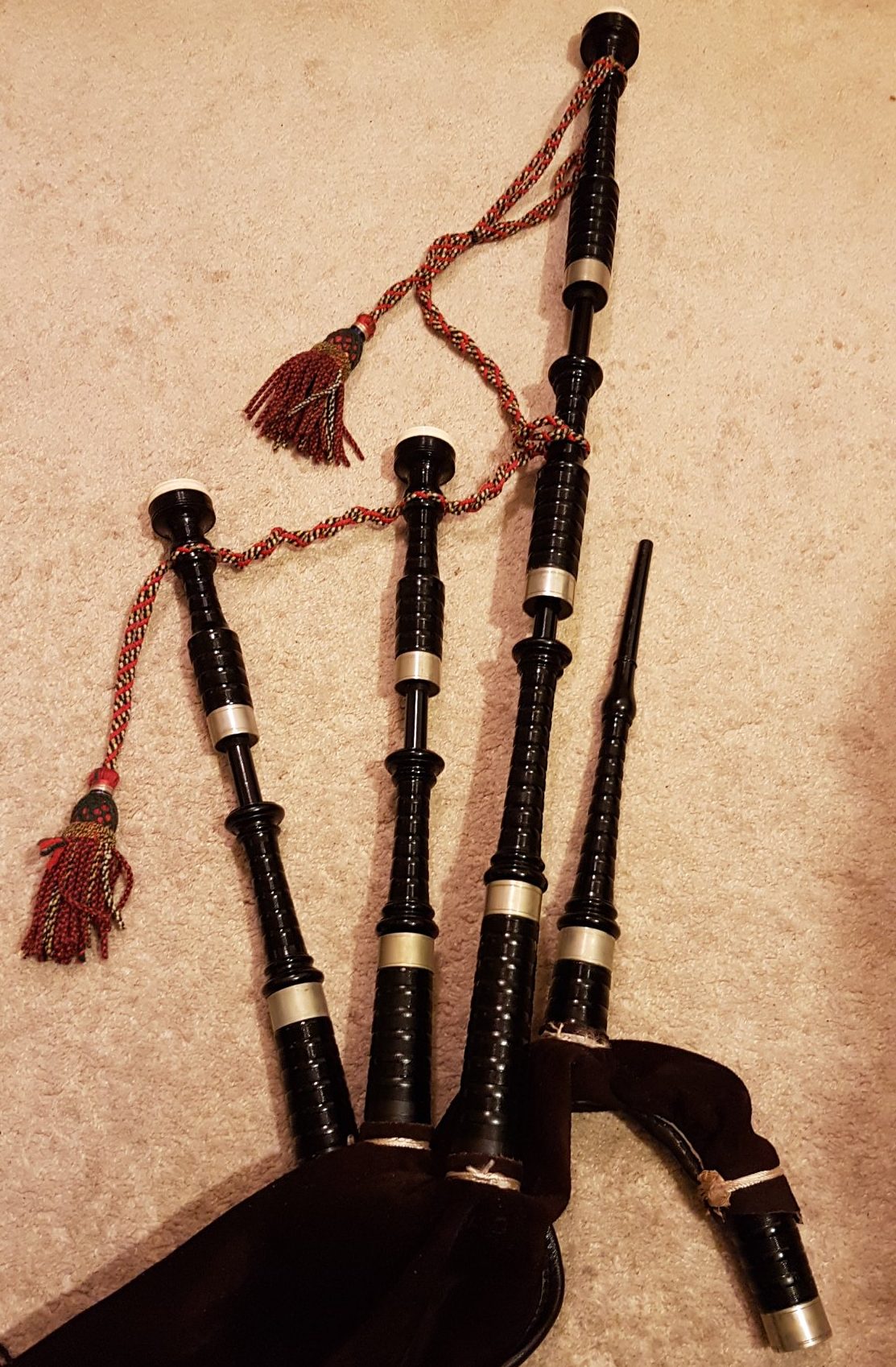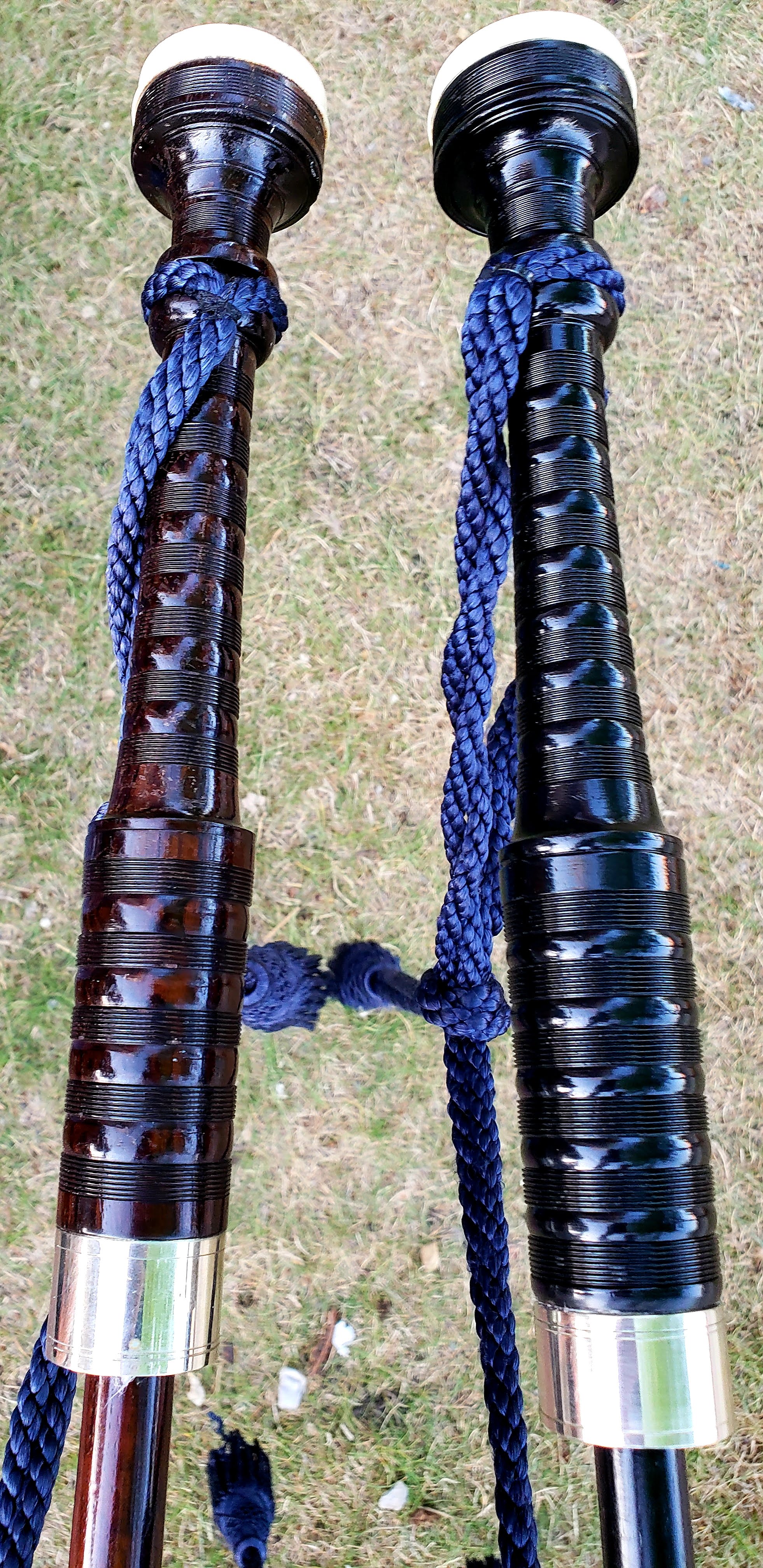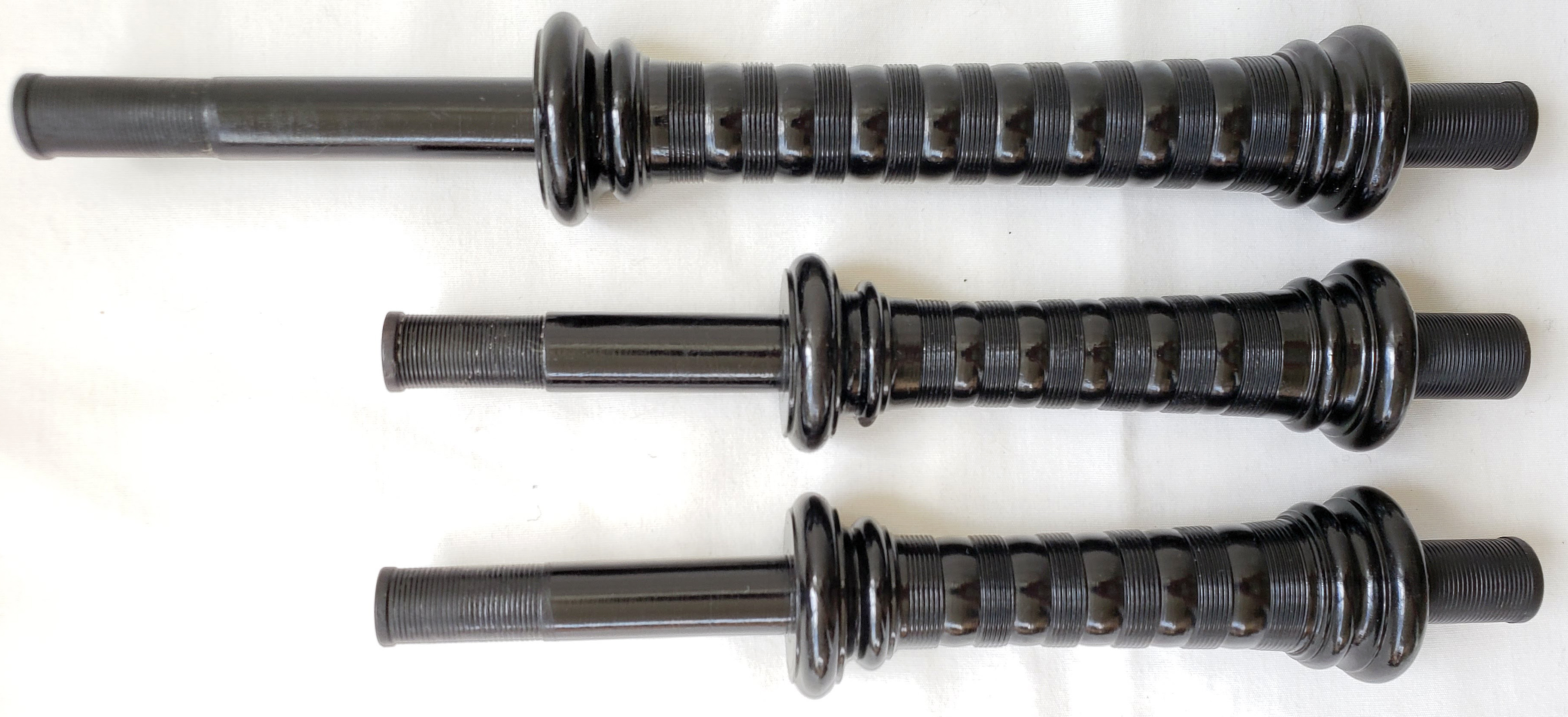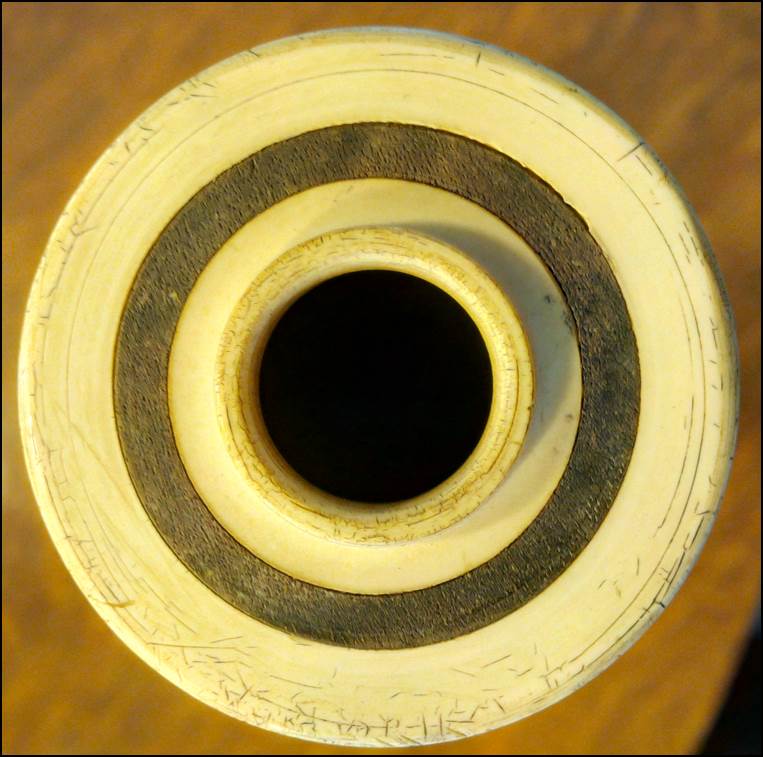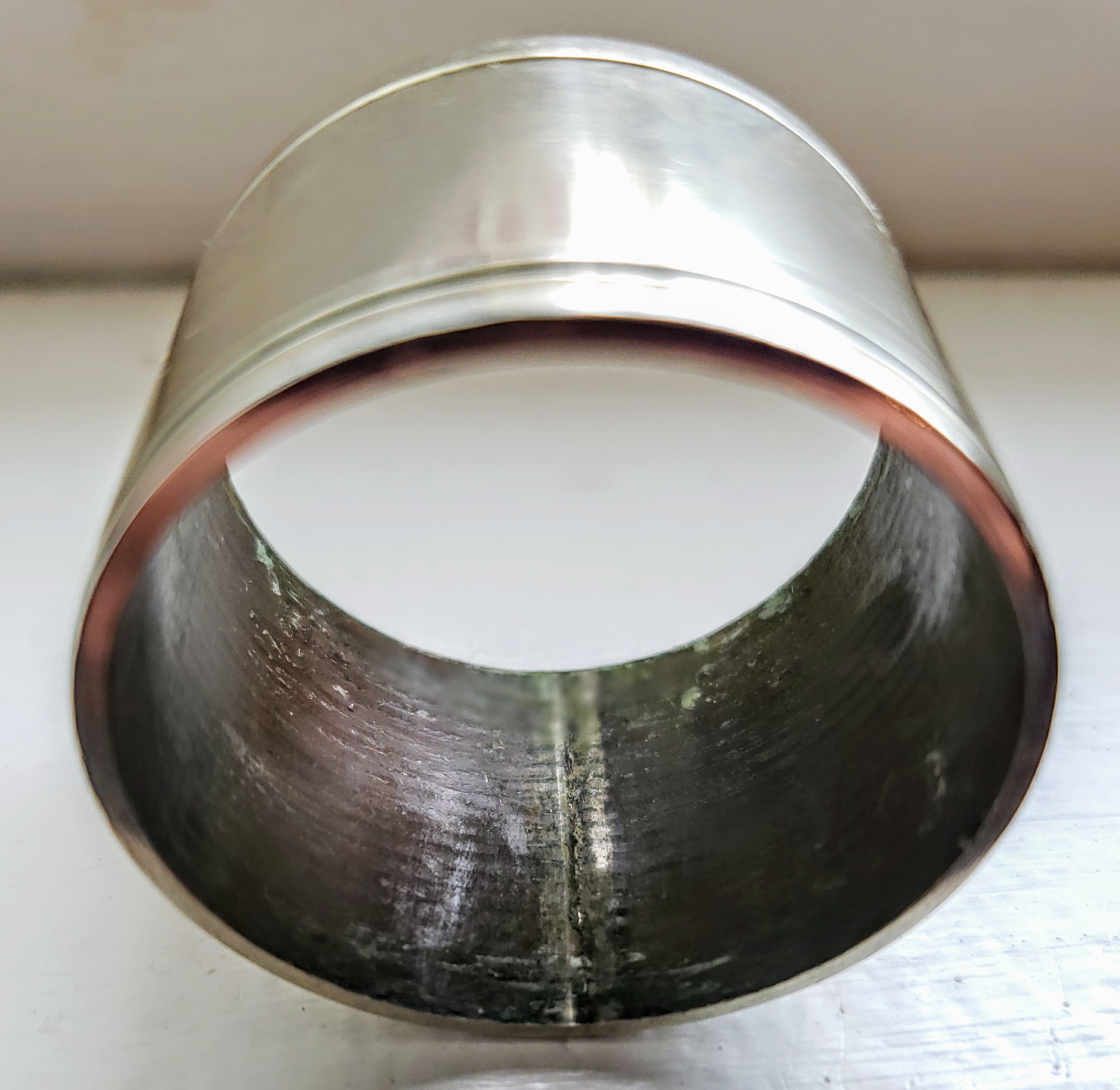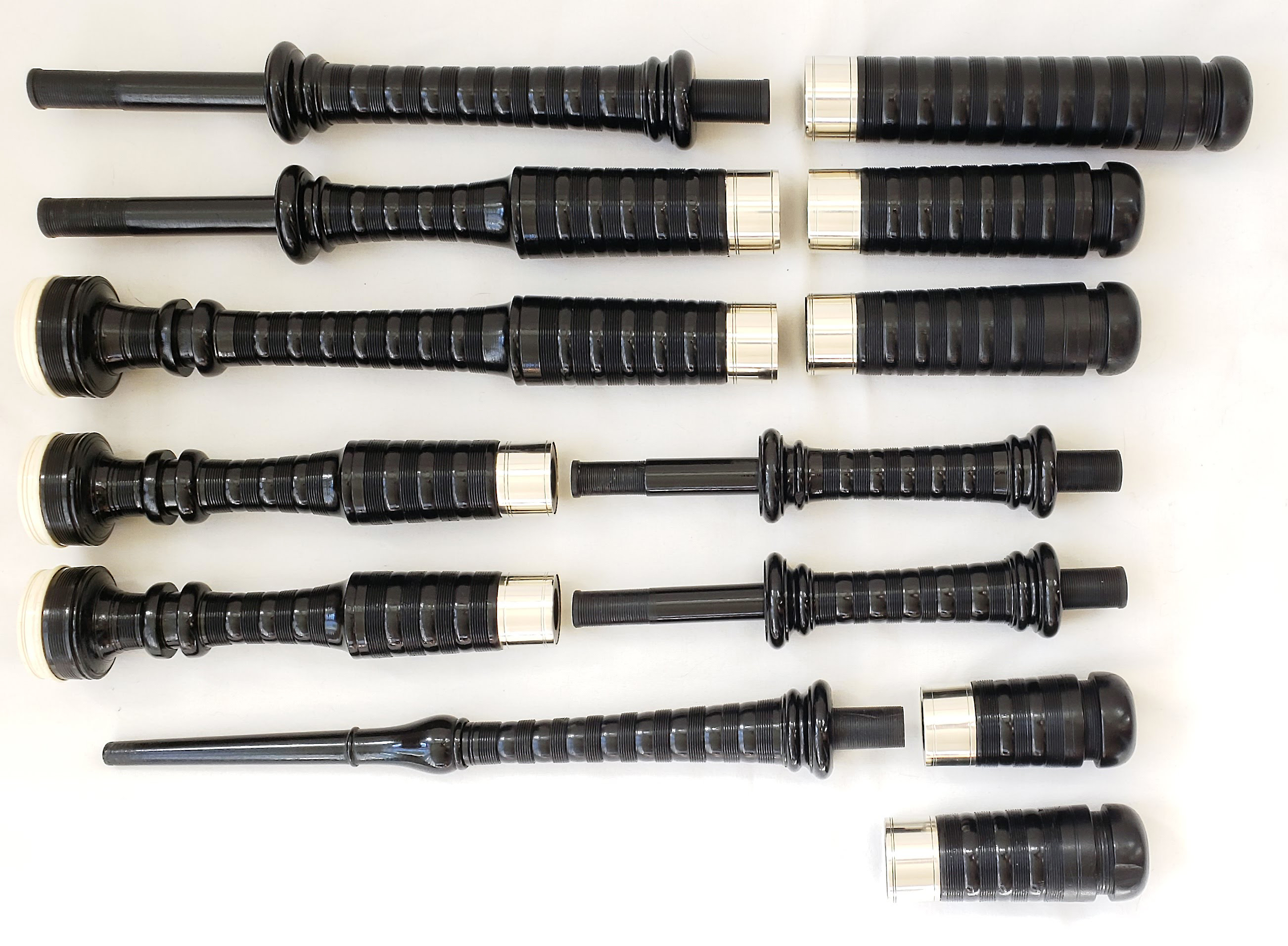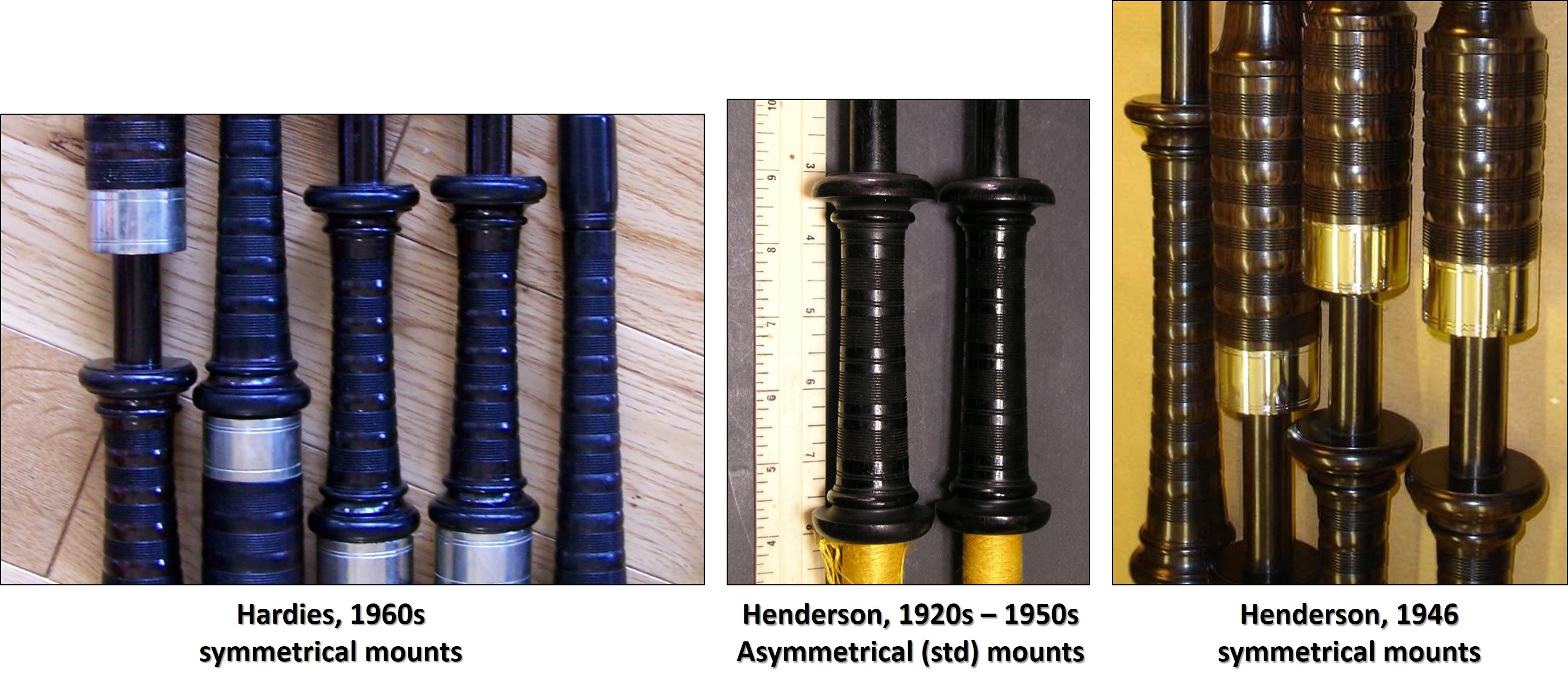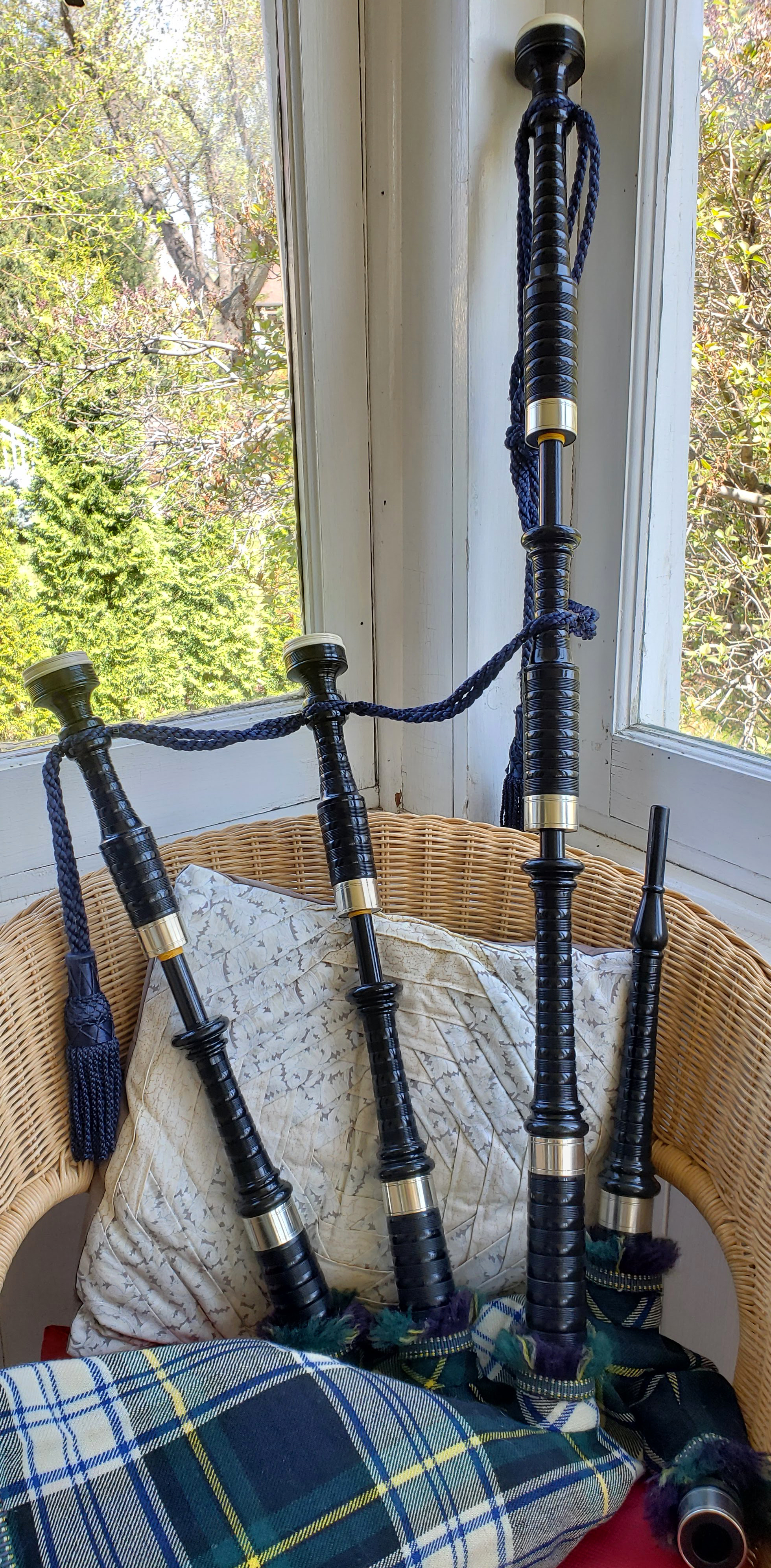The Beauty of Wood-mounted Bagpipes
I’ve always had a thing for wood-mounted pipes; while these non-ivory pipes were the absolute cheapest model available, they are a fine example of elegant understatement. Peter Henderson and R.G. Lawrie bagpipe makers have turned out many sets of wood-mounted pipes over the years. However, it is difficult to say when this style of pipes because popular. The early Henderson catalogs (E.g., 1888, 1890, 1904) did list them as an item but there don’t really appear to be any documented sets early than pre-1910, and very likely the teens. I can’t seem to find any R.G. Lawrie catalogues for comparison, but relatively early Lawrie (1900 – 1912) wood-mounted bagpipes can be found. In fact, there seems to be more evidence for 1900 – 1910 wood-mounted Lawries than Hendersons. Given the lack of evidence of very early wood-mounted pipes by these maker’s I think it’s safe to say that this style of pipe, at least from these maker’s, is a 20th century phenomenon. For more information this topic please read my page on dating Hendersons and Lawries by wood mount style here.
Back to the design of wood-mounted pipes. Wood mounts seem to accentuate the profiles of bagpipes unlike any other materials. They are very dark and create a unified profile. Wood mounts also vary in shape and style creating interesting profiles (see my page on dating Hendersons and Lawries by their mounts). With the right type of wood, in concert with well-designed profiles and bores, ‘simple’ pipes like these are the ‘sleeper muscle cars’ of the bagpipe world. This is particularly true of the early ebony or cocus wood versions of Lawries and Hendersons–their somewhat demure look belies a great big sound….
Before discussing wood-mounted Hendersons, I need to create a reference point. If you haven’t seen them yet, check out my WWI-era ebony wood-mounted Lawries here. With their varying width beads and comb numbers that follow the sweeping contours of the individual parts, to their closed and beaded ferrules, these are perhaps the most elegant-looking wood-mounted pipes ever turned. Period. Whoever designed and turned these pipes had keen eye on style and dimension. Compared to other wood-mounted pipes, including later Lawries, these pipes have a complex and feminine profile. The closed, slightly tapered ferrules are graceful and also make tuning a very comfortable experience. Here’s what I mean:
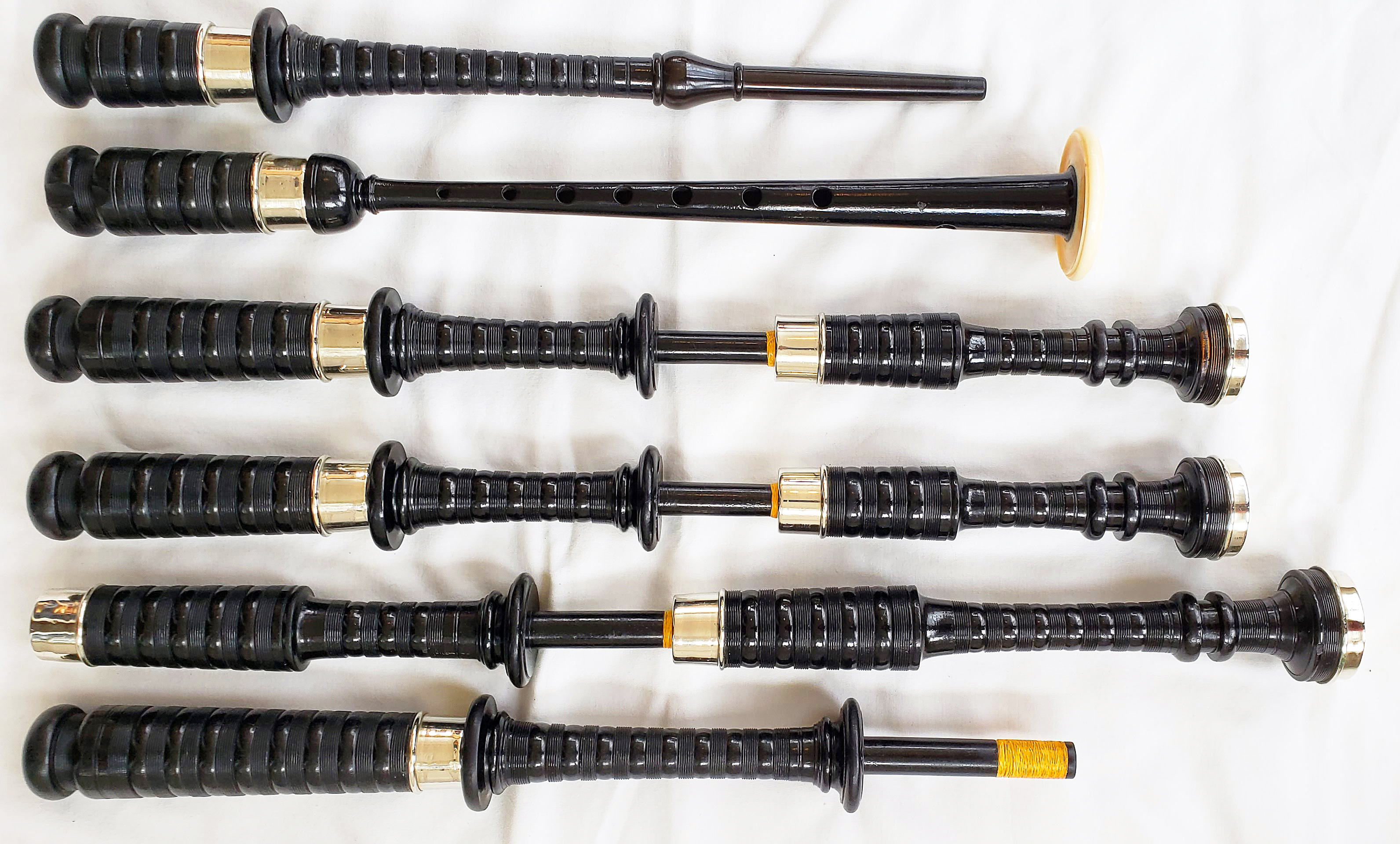
Perhaps the most elegant looking wood-mounted pipes out there: 1914 – 1920s era Lawries. Note the little sliver of sapwood on the outer tenor top.
Of course, the tone follows form in these Lawries; they are dynamic. The pipes have the largest bushes I have ever measured for Lawries, and they are larger than all Hendersons for which I have measurements, save one set with a tenor diameter that matches these. In any event, a bold, but very melodic and ethereal tone with a fantastically massive bass that follows you around wherever you go. These pipes are stunning at all levels. With their understated feminine profile and big bite of a tone they remind me of a black widow spider. But this page is about wood-mounted Hendersons…
Ebony Wood-mounted Hendersons
So, we’ve set the stage with perhaps the most beautiful design for wood-mounted pipes, IMHO, WWI-era ebony Lawries. Now, let’s talk about one of the Henderson versions of wood-mounted pipes. These are different than the Lawries, but no less lacking in style and tone…
As noted on my Lawrie wood-mounted pipes page, I originally set out to purchase a set of wood-mounted pipes for band. I sold my excellent celtic-engraved full alloy McCallum pipes to finance the purchase. However, due to issues of importing pipes from the UK into Canada after four months it looked like the transaction may fall through. I am glad that the seller was patient and our joint homework paid off — I ended up with the Lawries after all. However, while the issues of CITES export and import permits were being sorted out, a set of what were advertised as 1950s button-mounted African blackwood Hendersons with plastic bushes and ring caps became available for sale. I believe that some call this style of mount button mount; it tends to be a little smaller in diameter than most other mounts. However, there are even smaller wood-mounts that are more simpler in profile may be more properly referred to as button-mounts.
The Hendersons here had a cracked blowpipe and stock, some reversed ferrules, at least one mismatched part, and the tops of the stocks appeared to have stress cracks. However, all three drone tops were marked P. Henderson and otherwise the set looked solid. They were not really in my budget, but after a couple weeks of negotiating and with the prospect that the Lawries may not arrive, I decided to take a chance that these pipes wouldn’t need too much work to make them serviceable. Here’s an image from the ad:
The pipes were graciously delivered by the seller to Rick Pettigrew at Dunbar Bagpipes to inspect the severity of the blowpipe and stock cracks, check for other issues, and to potentially have a duplicate blowpipe and blowpipe stock made. The cracks turned out to be repairable but expensive, plus the original blowpipe has a very small diameter. Given these pipes appeared to be quite dark and their original varnish mostly shiny I elected to get poly reproductions made of the the blowpipe and stock. A friend of mine in Ontario was kind enough to supply a spare Henderson ferrule with an extra — thanks, Bill! The parts were turned, the pipes further inspected, and the finish deemed to be in good enough condition that it was not necessary to refurbish them, though Dunbar does an outstanding job. The pipes with extra parts soon arrived at my door. They were a little dirty here and there, especially the bores, and the ferrules were tarnished. After many hours of cleaning, oiling, polishing, and re-hemping I discovered a few interesting things about these pipes…
The Priest’s Pipes
First the history. I love researching the background of pipes and the seller was able to relay a little bit of information on these Hendersons. Apparently a priest purchased them in Scotland years ago, new or used I do not know. He eventually sold them to a gentleman in Ottawa who never played them. They were then sold to the seller I purchased them from, and he did did not play them much (might of had something to do with his current outstanding stable of pipes). So, at this point I was purchasing these as 1950s African blackwood and plastic Peter Henderson bagpipes as the third or fourth owner.
Ebony
Second, all the pieces appear to be ebony and not blackwood. I verified this by examining chips on the mount and one tenor top, scraping the inside of the bores, and scrutinizing the wood here and there with a bright light. I even sent some images to a couple of experienced friends who suggested the pipes were ebony. Every part appears to be turned from a jet black and very dense-grained wood. If you can any doubt, chech out this comparison of Henderson bass tops in African blackwood (40s-50s) and these Hendersons (teens – 20s):
The wood is pretty much identical to the ebony in my wood-mounted Lawries; putting the two sets of pipes together there is no apparent difference. For a final check, Ron Bowen has more or less the same set with some variance in colour on his website. So, ebony! This new information is beginning to move the date of these pipes from the 1950s to an earlier period, likely well before 1930 during a time when African blackwood was less common.
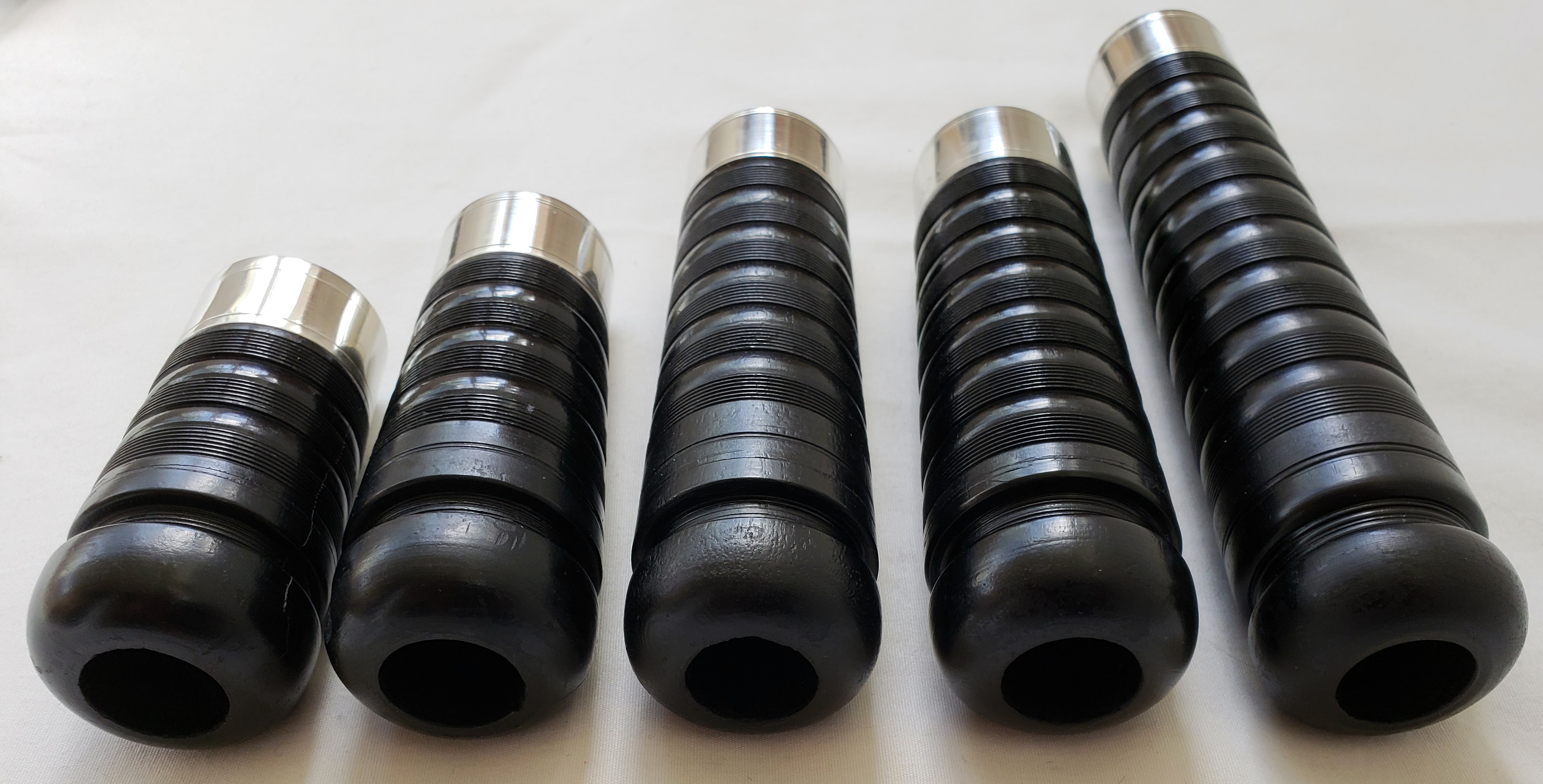
Stocks from an oblique angle. I scratched each one inside down to the wood while cleaning off gunk and everything is jet black.
Casein
Third, the bushes and ring caps were not plastic nor catalin, but casein! The amount of degradation appears to be quite minimal on these pipes. This is not what I (or others) are used to seeing. No wonder the caps were identified as plastic or catalin (the latter which eventually turns orange). So, now we’re moving the date of these pipes to an even earlier period, possibly pre-1920 and into the teens. Here again, Ron Bowen has pretty much the same set on his website. All parts seems to match but with varying degrees of quality of casein on the ring caps and bushes. It’s excellent on the bass, very good in the middle tenor, and good on the outside tenor. That which we see on the bass must be very close to what casein originally looked like. Here the drone tops in order of casein condition, bass, tenors:
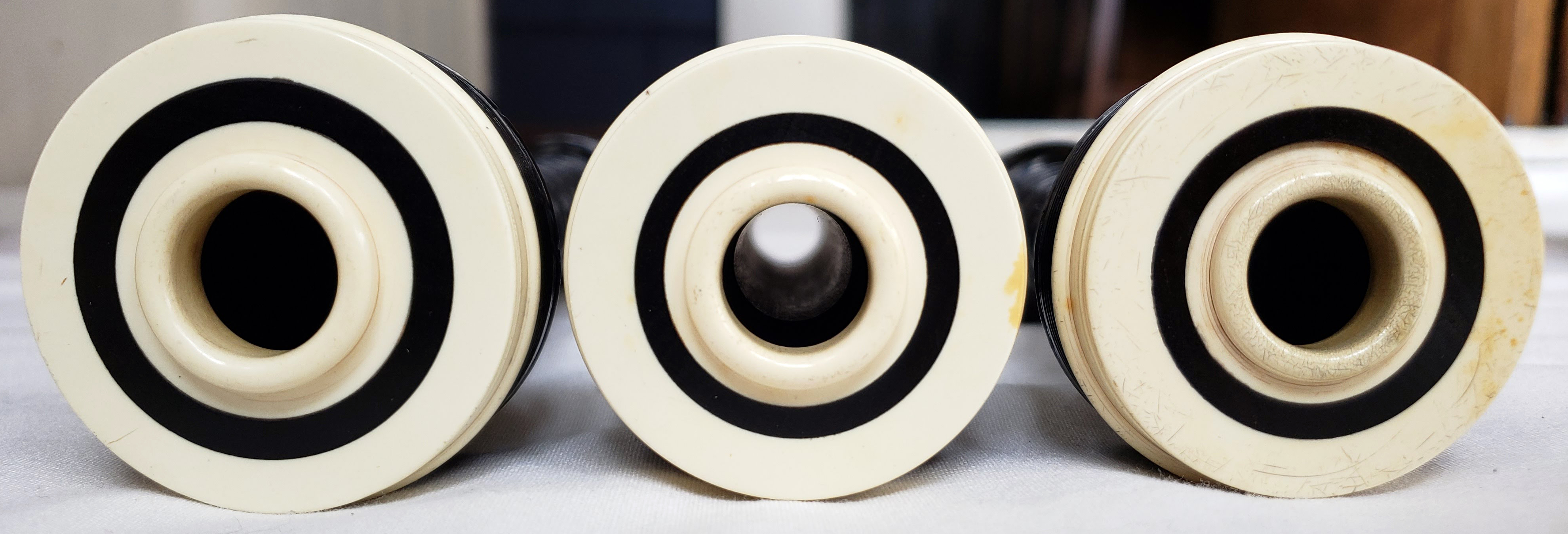
Casein ring caps and bushes on mid-teens to 1920s set of ebony Hendersons. Bass is the best in condition and on the left.
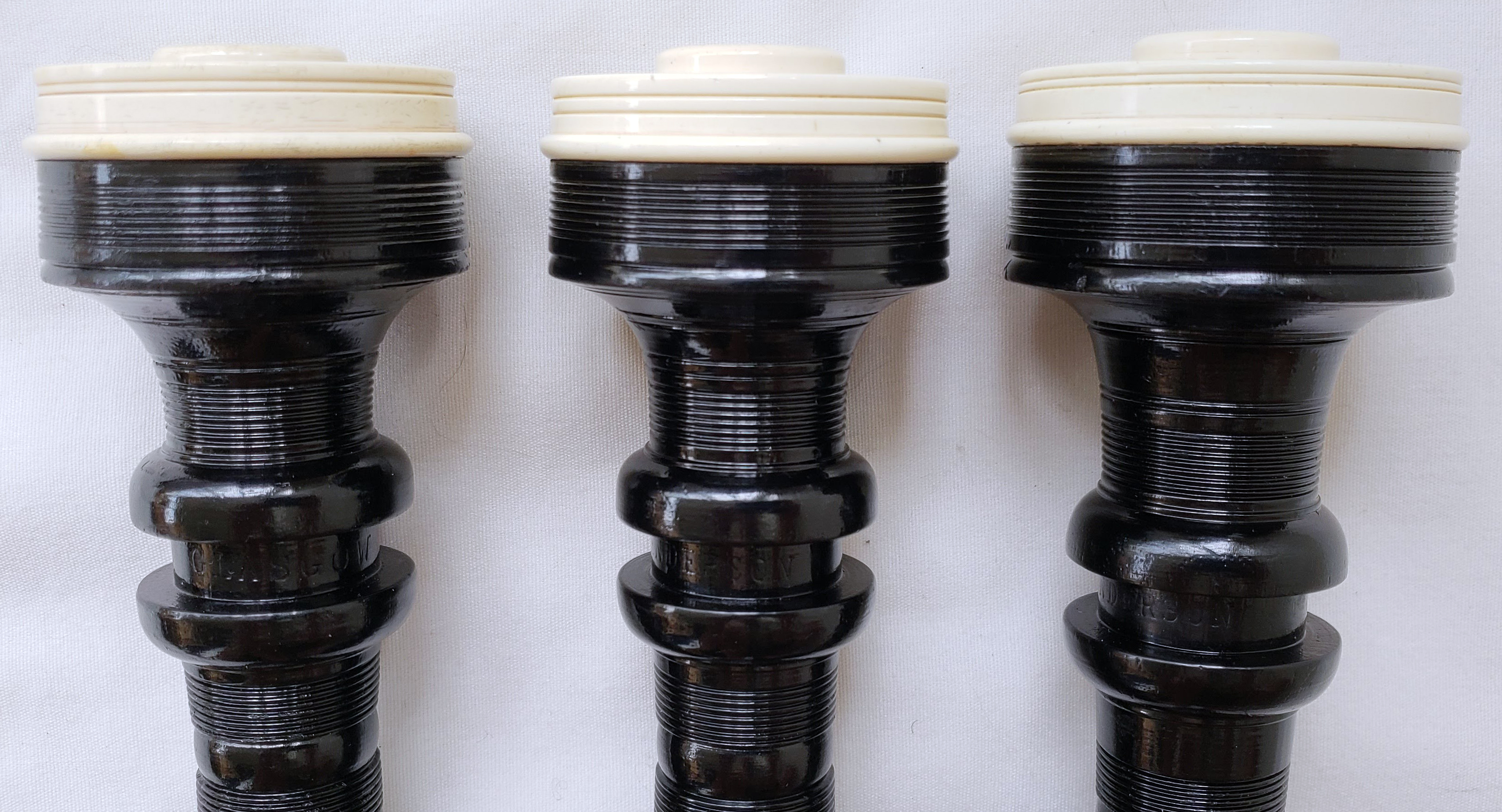
Side view of drone tops with casein ring caps and bushes on mid-teens to 1920s set of ebony Hendersons.
More on another page soon, but casein is a very interesting material. It was developed around 1900 in Germany from milk protein exposed to formaldehyde. The trade name was Galalith and was also marketed in France. Apparently, some grades of casein took a year to set in the solution, Casein often came out quite misshapen but very stable and able to readily accept dyes. It would then be cut into blocks or cylinders and fashioned into various household objects, including buttons, kitchen utensils, and knitting needles. By 1911, Britain was making its own version called Erinoid. This was timely because imports of Galalith from France and Germany ceased in 1914 due to WWI. War blockades would have slowed and stopped all manner of shipping, including other supplies of typical bagpipe materials like cocus wood, ebony, and ivory. This would have very likely been the time that the locally-produced Erinoid casein was adopted by Peter Henderson bagpipes as cheap and durable replacement for ivory. Casein would have been used on the lower cost models, including wood-mounted sets. However, it appears that this material was short-lived on Henderson bagpipes, replaced sometime in the 1920s by catalin. Robertson bagpipes also embraced casein, and used it much longer, possibly into the 1940s and 1950s.
While casein appeared to be an excellent ivory replacement at the time we now know that much of it becomes cracked and discoloured over time. Here’s an example from a circa teens – 1920s ebony flat-combed Henderson tenor top I have:

Profile of a casein-mounted tenor top from a teens – twenties ebony flat-combed Henderson. The lower bead is actually quite chipped on the opposite side.
That said, it has become clear that some grades of casein were far better than others; while there are some horrid examples of casein on Henderson (and Robertson) bagpipes, I do believe that some of the best casein was also used on Hendersons, including this set.
OK, let’s look at my three drone tops in order of casein condition, and add a fourth from a flat-combed ebony Henderson tenor top with a very degraded casein bush and ring cap:

Casein tops from my WWI- -1920 ebony Hendersons in declining order of condition, along with a very degraded example of casein from a flat-combed ebony Henderson tenor top of the same era.
While some would elect to replace the casein on the ebony set of Hendersons with plastic I would not consider it; the condition is far better than average, the aging and stains add character. Plus, casein helps to date the pipes as mid-teens to 1920s.
Date Stamps: Glasgow!
A fourth discovery was the marks. While I knew that all three drone tops were marked as P. Henderson I wasn’t certain if other marks were included.
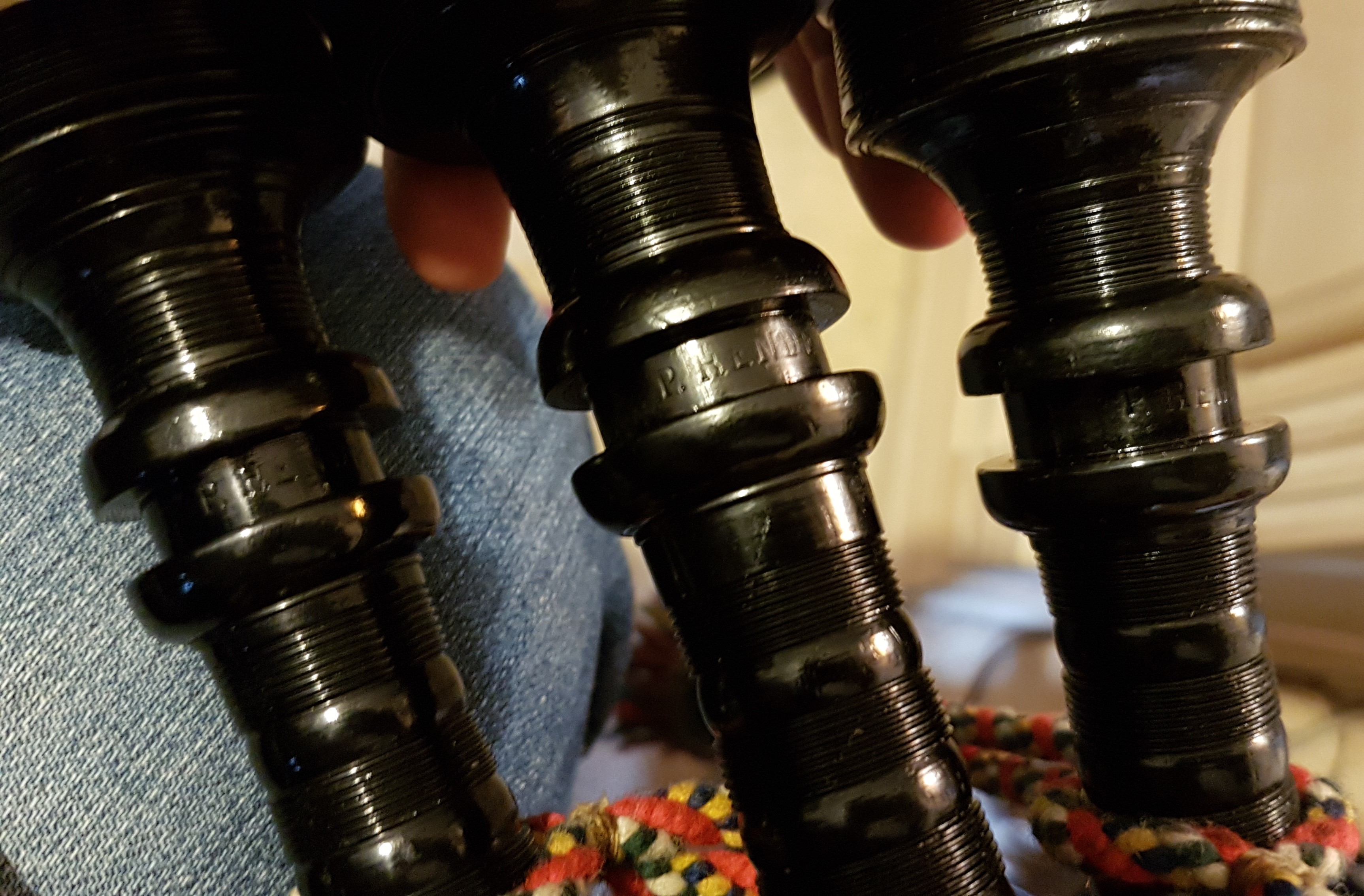
P. Henderson stamps visible in between the drone cord guides, the most typical location for Henderson marks.
It turns out that one tenor and the bass are marked P. Henderson and the second tenor is marked as P. Henderson Glasgow. Ron Bowen has posited that Henderson bagpipes marked with Glasgow may well be the earliest examples of the Henderson mark, though this is not definitive. The Peter Henderson company was incorporated in 1929 and shortly thereafter many Hendersons were stamped as Peter Henderson Ltd. While marks on Henderson pipes varied widely with up to six different permutations (please see my treatise on this here), the inclusion of Glasgow and the lack of Ltd are further evidence that these pipes were likely turned sometime in the teens and possibly into the 1920s before 1929.
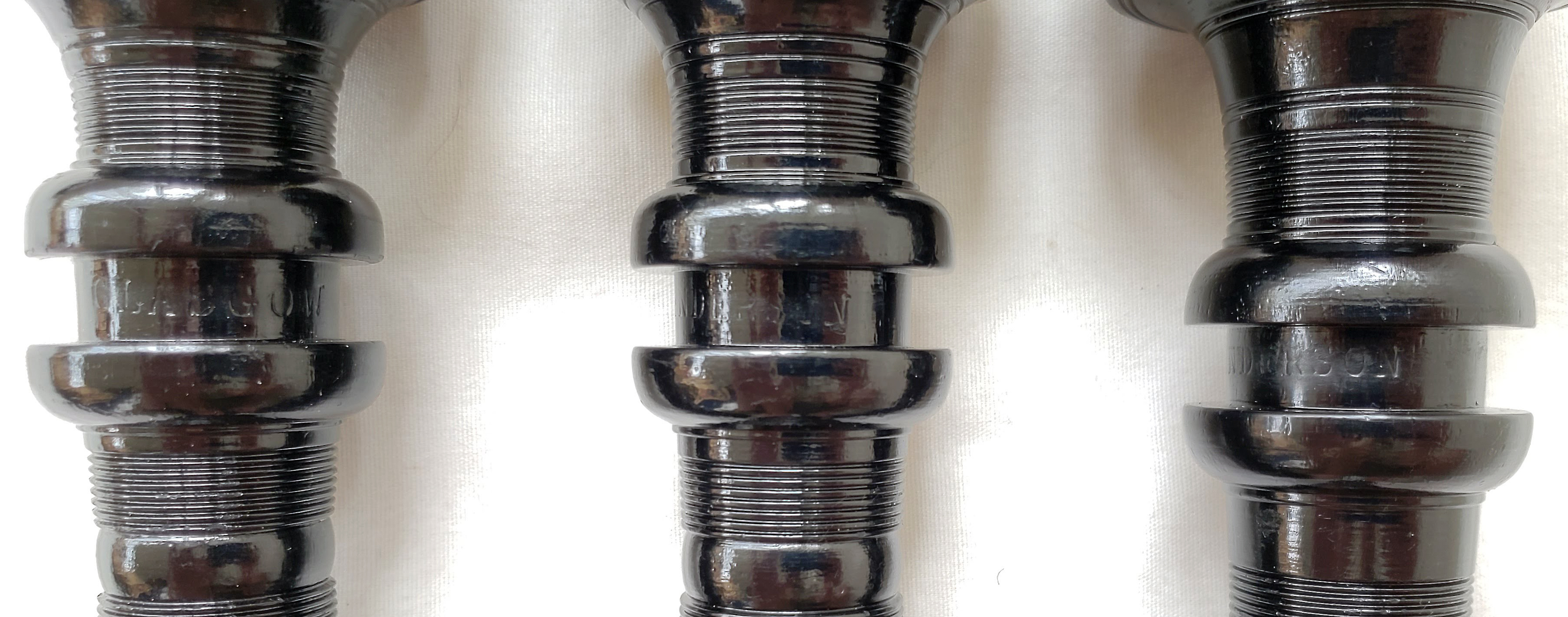
WWI – 1920s ebony wood-mounted Hendersons with stamped marking in the cord guides. One tenor and the bass are marked P. Henderson and the other tenor is marked P. Henderson Glasgow. having Glasgow potentially suggests a pre-1929 bagpipe.
Thick, Seamed Ferrules
The fifth discovery was confirmation that these pipes have thick, seamed ferrules, the type that is considered to the be earliest on Henderson bagpipes. I have thickness measurements of the ferrules from three sets of Henderson in the teens to twenties time frame and they vary between 0.0520 and 0.0560 inches. A set of catalin-mounted chalice topped Hendersons from likely the 1940s-1950s have seamed ferrules but with a thickness of only 0.2500 inches. According to Ron Bowen, early Henderson ferrules were cut and formed from flat stock then soldered. Here’s an example of a thick, seamed ferrule from a teens to twenties flat-combed ebony Henderson tenor top:
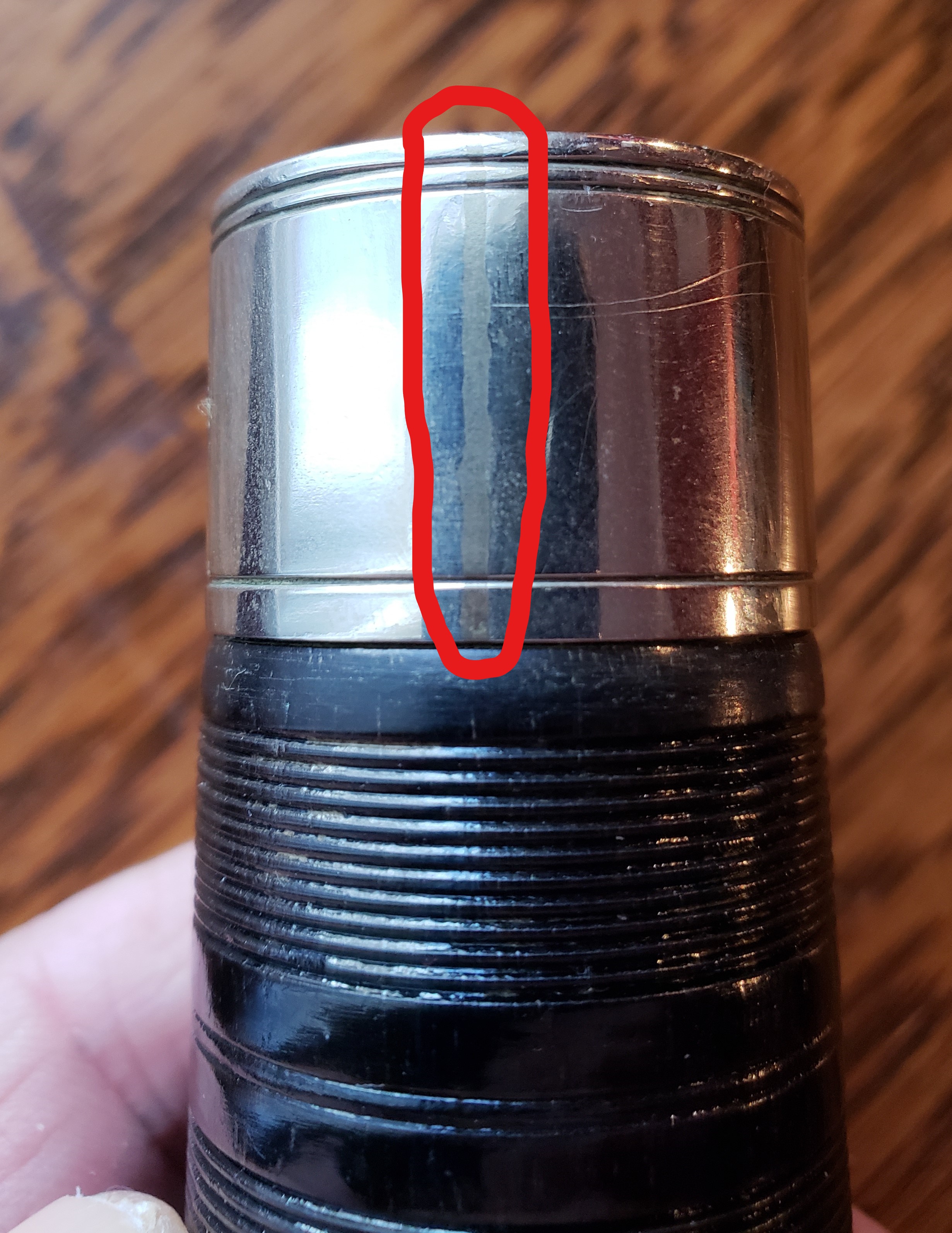
Seamed ferrule on a circa 1920s casein topped ebony Henderson tenor top. The seam usually a little more visible when the nickel has oxidized.
While three or four of the ferrules on my pipes had been reversed and / or mixed on parts sometime in the past, they all appear to be original to the pipes. Later Henderson ferrules appear to be crafted from round stock and did not require soldering and thus, are seamless. I believe that the earliest ferrules were made of a very high quality nickel and are easily re-polished. Later Henderson ferrules are still quite thick but don’t appear to re-polish up as nicely (at least with 00 steel wool, as I recently found out with the finish taking on a brushed look that was sort of reversible). Here are the old style, thick, seamed ferrules on my teens – twenties set before they were polished:
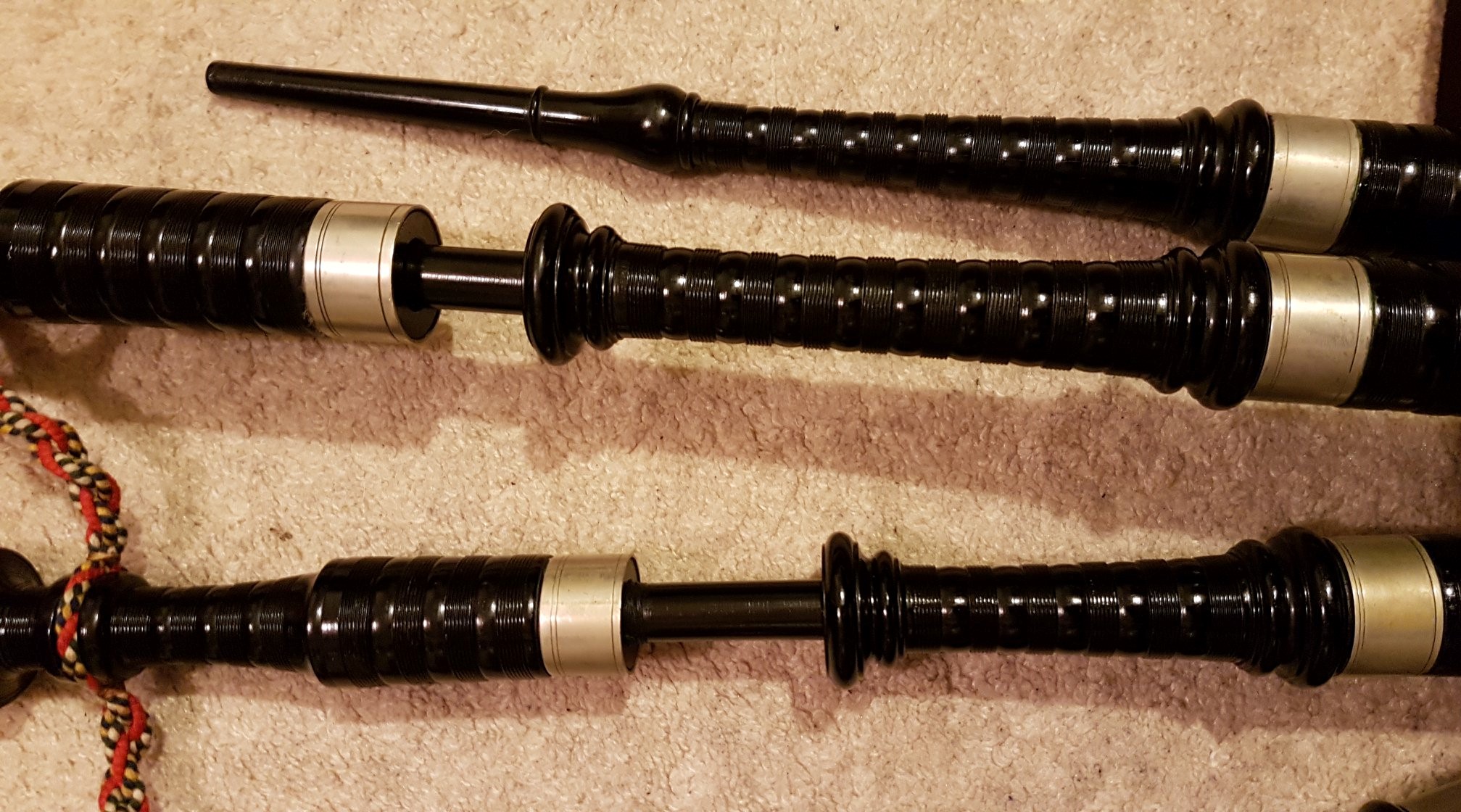
Oxidized ferrules on WWI-1920s ebony Hendersons. These ferrules are seamed and very thick. One seam appears to be visible in the image.
And here are the ferrules after polishing with 00 steel wool and paste wax:
Slightly Different Parts…
So, here we have a relatively original set of mid-teens to twenties ebony wood-mounted Henderson bagpipes with casein bushes and ring caps. I say relatively original because there are a couple of slightly different parts. First, notice that one lower tenor joint has subtlely different beading and combing. Details on the hemp stops, hemp space, and bottoms are also slightly different. While the external dimensions and the mount turning are similar, but not identical, the internal dimensions are completely different (0.3230 vs 0.2850). Henderson lower tenor bores are generally well over 0.3000. The smaller bore is so small as to make it difficult to oil and or dry with a standard bore brush! Was this an original design? Was one of these a replacement? Which is original? Were these military bagpipes assembled from a box of parts? It’s hard to say other than the materials, finish, and condition are the same, and they were likely turned in the same era. At first I doubted that I would consider re-boring this part as it has lasted this long and there are don’t appear to be any real performance issues. That said, the smaller diameter raises the pitch slightly. A little space is required between the reed and the seat in order to drop the drone to the level of the other one. See below for the averaged bore dimensions compared with my other WWI Henderson and WWI Lawrie. After playing these pipes for a few weeks I noticed that the tenors seemed to perform at different pressures, i.e., I need fully pressure to bring both into tune and locked. I sent both lower tenor parts to Dunbar who re-bored the smaller part to match the larger one; the performance improvement was immediate and they even appear to sound a little more full.
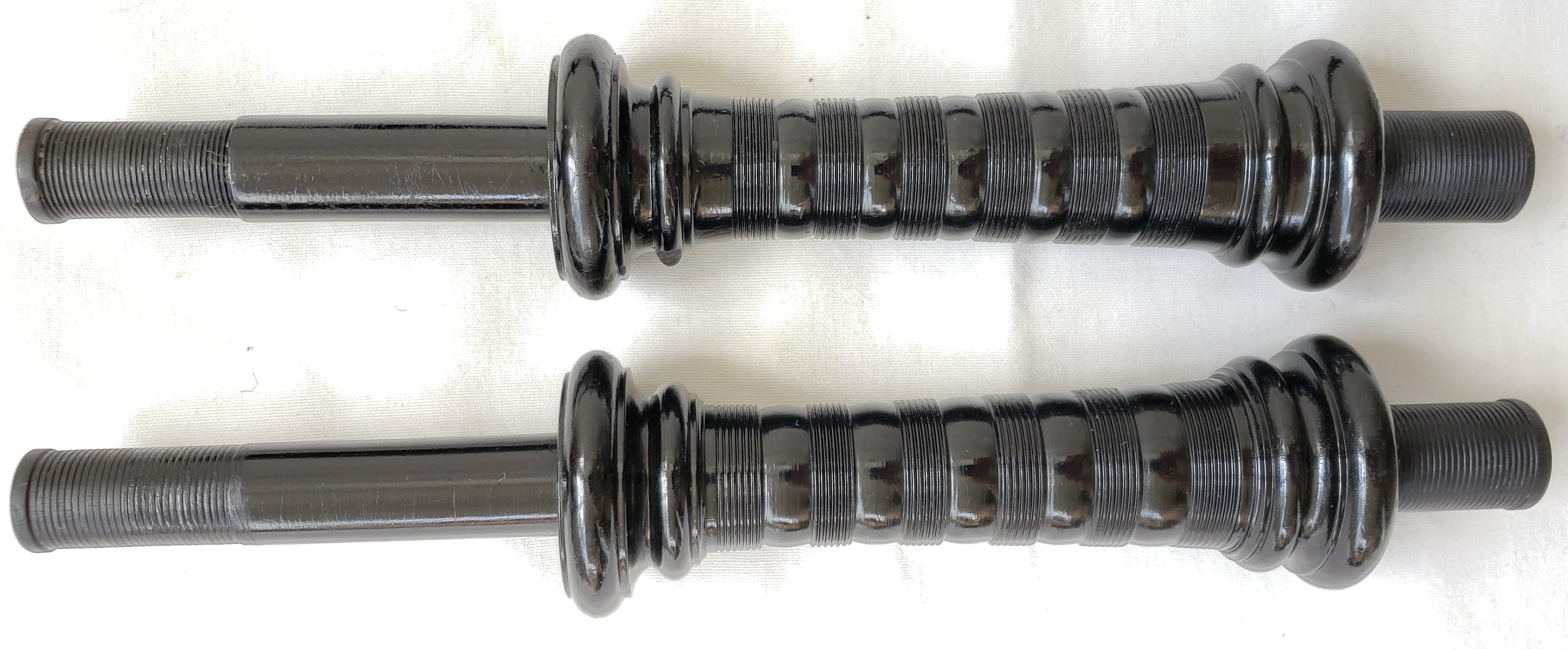
Slightly different lower tenor sections of WWI-1920 Hendersons. The bore of the lower one was so small that it is difficult to oil and or dry out the bore with a typical skinny bore brush. I had the part bored out to match the larger one and performance was improved.
As an aside, someone had done an excellent job of threading the lower sections to accept reeds — reeding is a breeze.
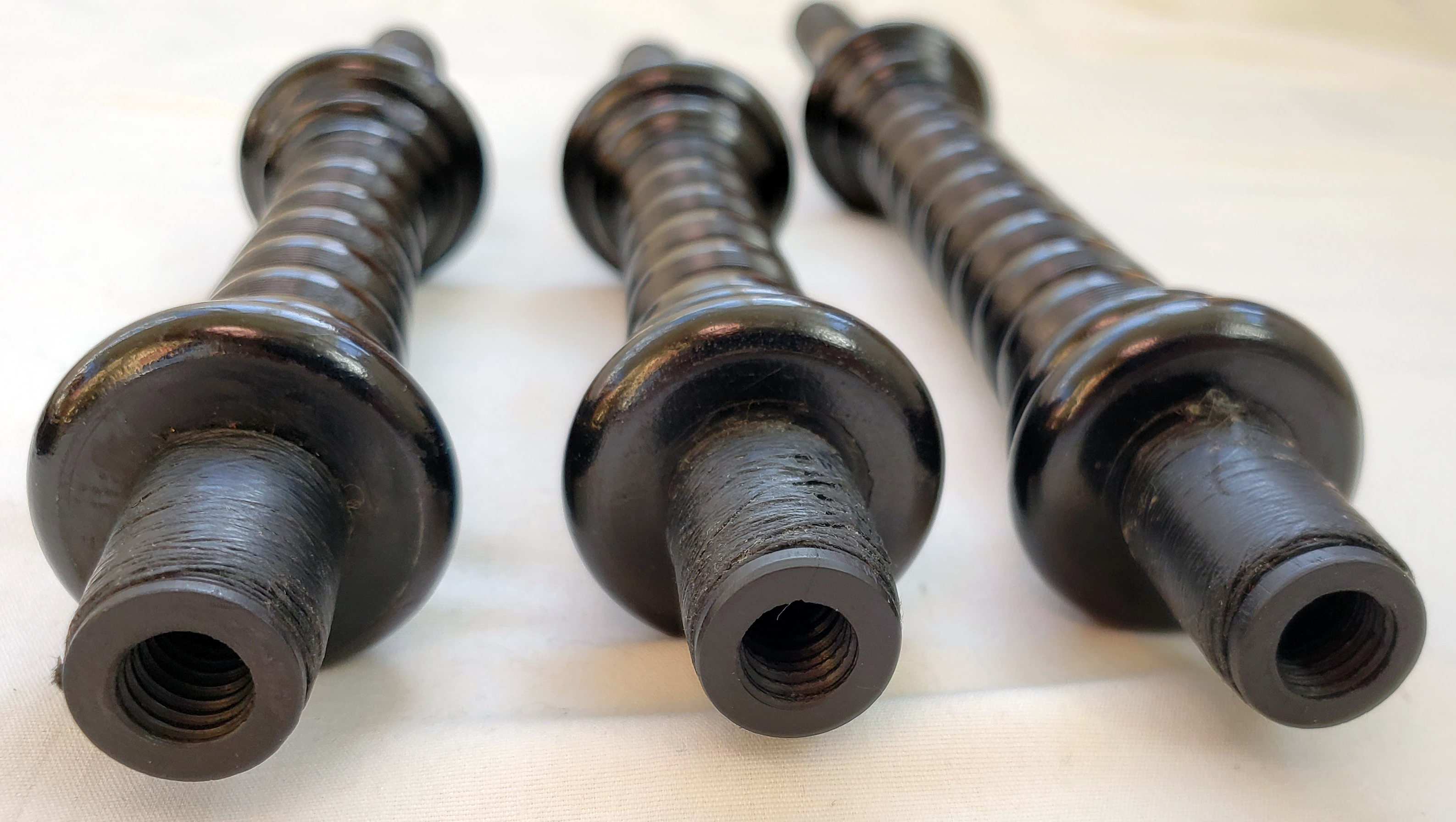
Threaded lower sections on ebony Hendersons make reeding the pipes very easy and, in this case, probably necessary given that one of the tenors has an incredibly small bore!
Also noteworthy is that the tenor stocks are slightly different, with one appearing to be older or at least more used. The ferrule also appears to be more worn. Many vintage pipes have parts that are slightly different and quite probably came out of the factory this way. There are stories of individual turners working on single parts over a course of time which would later be assembled from the stock of turned parts. The same occurred when military pipes were assembled from parts in boxes for issue to pipers. That said, all of the dimensions of the stocks in question are similar, including the bores:
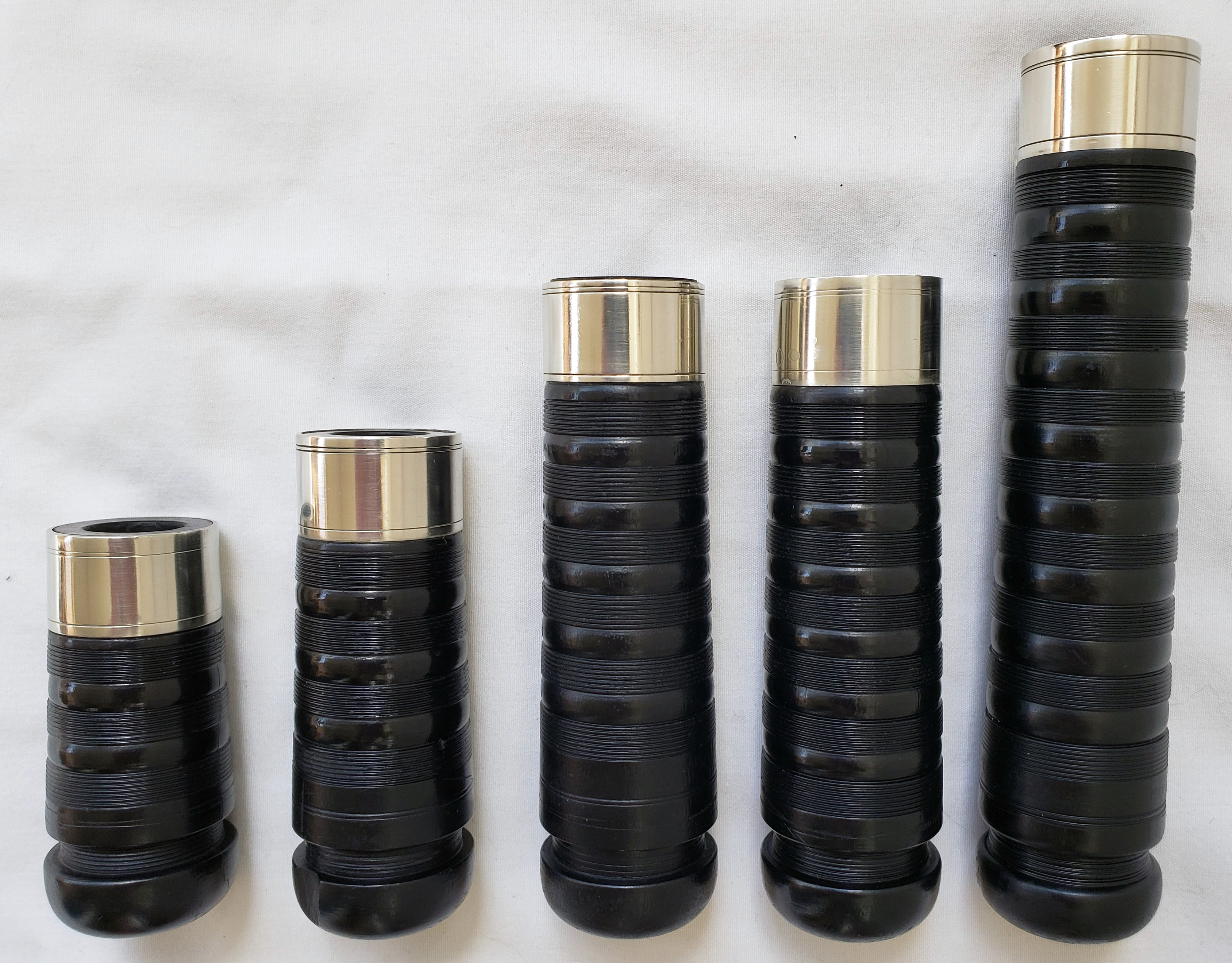
Ebony stocks with two slightly different tenors. Did the pipes comes from the factory like this or is one a replacement?
Wood-mounts and Dating
If you’ve read my page on dating Lawries and Hendersons by wood mounts you’ll know that dating Hendersons by mount type is not reliable. With Lawries we seem to have a pattern and can, with details like ferrule type, fairly accurately date them. Here’s an example from that page:
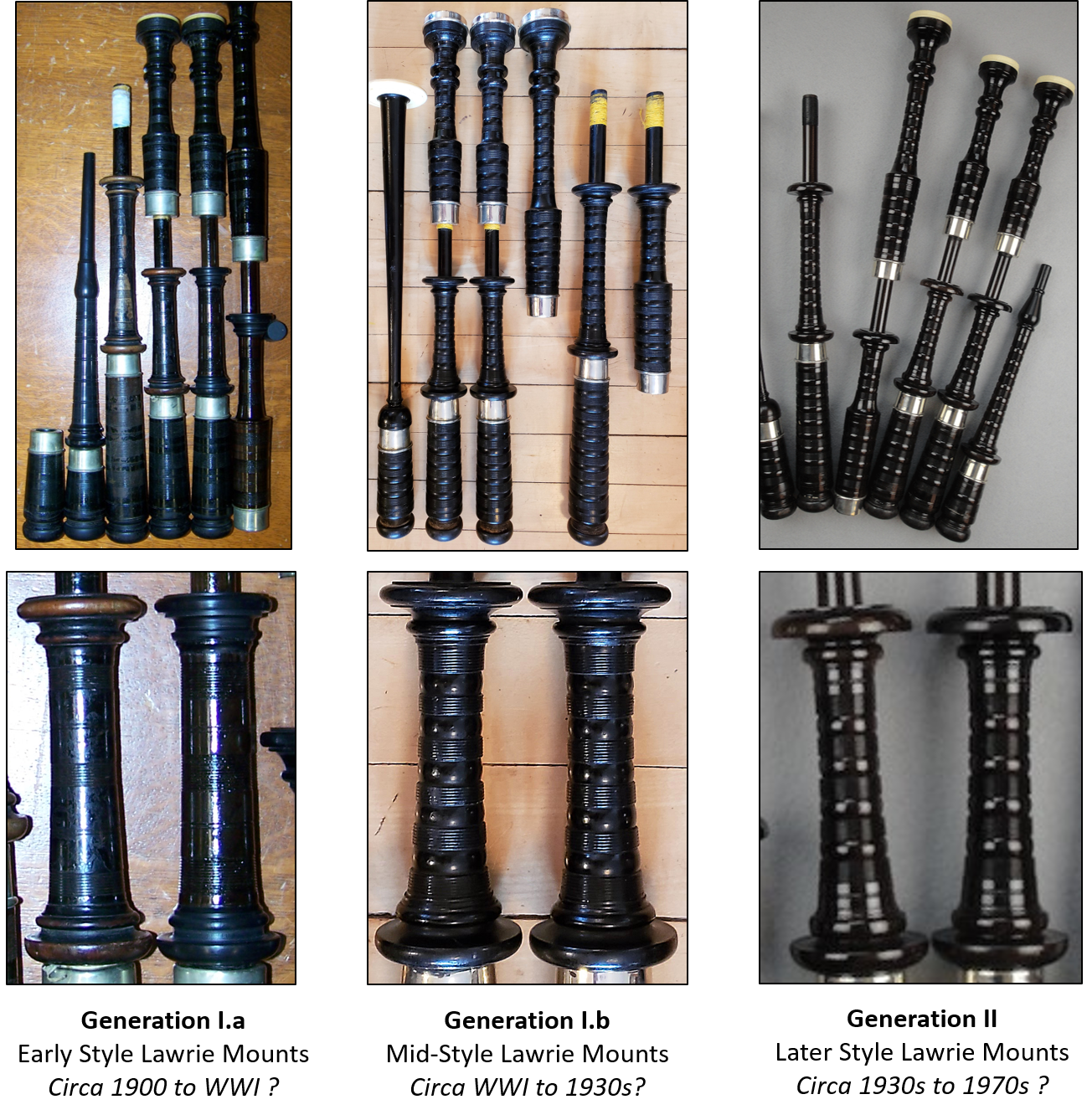
Three generations of Lawrie wood mount styles. First set of images from Gord MacDonald at Island Bagpipes. Set two is mine, and three from Jim McGillivray’s Vintage Bagpipes page. Note, the similarities among Generation I mounts. The I.a style appears to be quite rare and associated with scribe-lined ferrules. Scribe-lined ferrules with little taper are posited to be from 1912 or before.
With Henderson there seems to be no real pattern. Henderson wood-mounted pipes appear mainly to have their very unique spool-like / mushroom profile as we see on my Hendersons. Here the top mounts are symmetrical and the lower mounts reverse mushroom-shaped. More rarely we see the asymmetrical style mount on Hendersons that are basically the Generation II mount we see on later Lawries (see above). The spool-like / mushroom profile mounts appear to be found on the earliest to the latest Hendersons. They are also found on Hardies and probably other makes. The typical mounts one sees on most wood-mounted pipes by different makers are also seen on some Hendersons. However, these are quite rare and appear to be associated only with flat-combed Hendersons. Here’s a comparison of the two types of mounts:
And here again are the profiles of the mounts from my pipes which seem to be the common Henderson wood mount style:
Thus, dating Hendersons by wood mounts is somewhat futile, and other clues such as type of wood, thick and seamed ferrules, and bush and ring cap material are necessary to narrow things down.
Teens to Twenties Ebony and Casein-topped Wood-mounted Henderson Bagpipes
So, we can now say with some certainty that this is a set of mid-teens to twenties ebony wood-mounted Henderson bagpipes with casein bushes and ring caps and the older style thick, seamed ferrules. Note earlier that I stated that WWI – twenties wood-mounted Lawries with beading and combing are the most elegant wood-mounted pipes out there. They still are. However, these Hendersons are no slouch in the looks department. While their form is still elegant, this design leans towards something beefier and more masculine-looking, IMHO. Even the ferrule colour is different; whereas the Lawries have a warmer tone to the metal, these old Henderson ferrules are bluish. They appear to me to be more masculine in profile. So, if the ebony wood-mounted Lawries are the black widow spider of bagpipes, then the ebony wood-mounted Hendersons are the black, hairy tarantulas! The lines are straighter, the parts more robust (and noticeably heavier than the Lawries), the mounts thicker and less wide, and the ferrules more sharp and rigid-looking. All in all a venerable-looking bagpipe. Here are few more images…
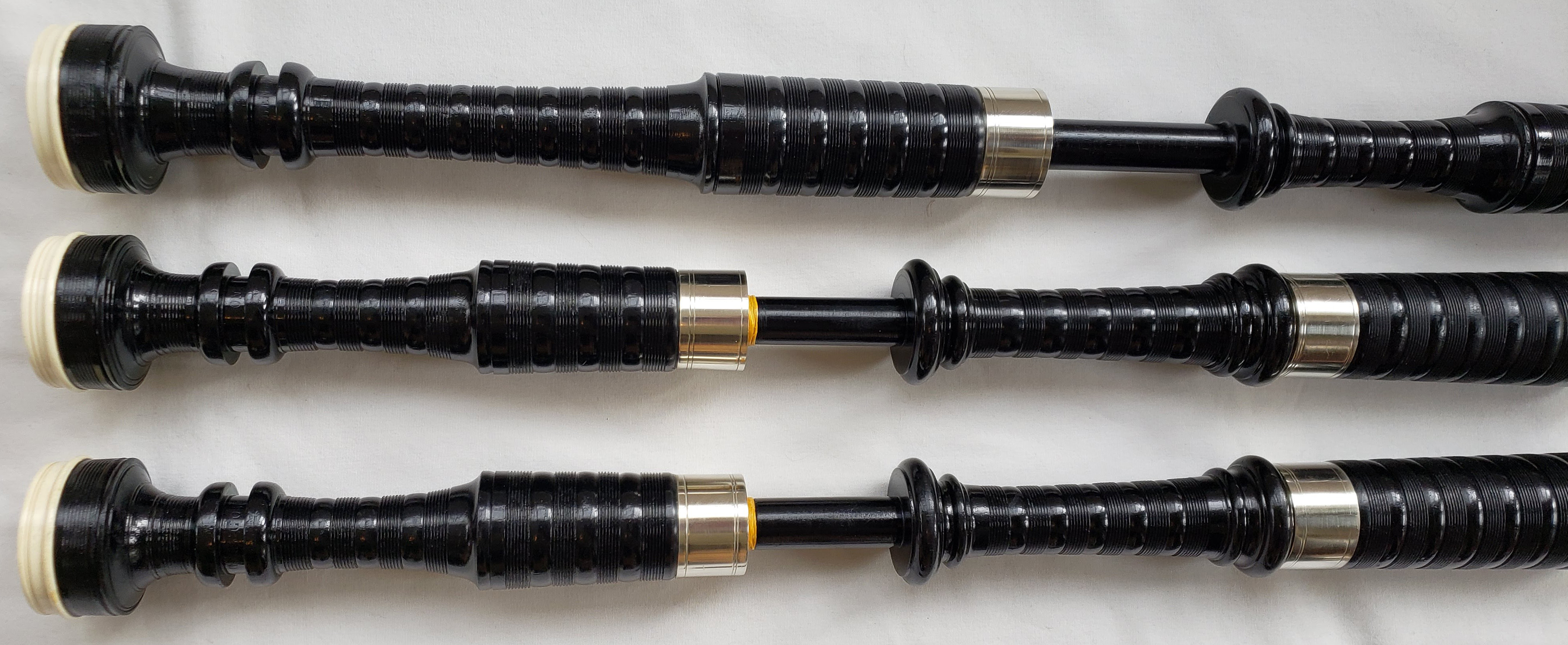
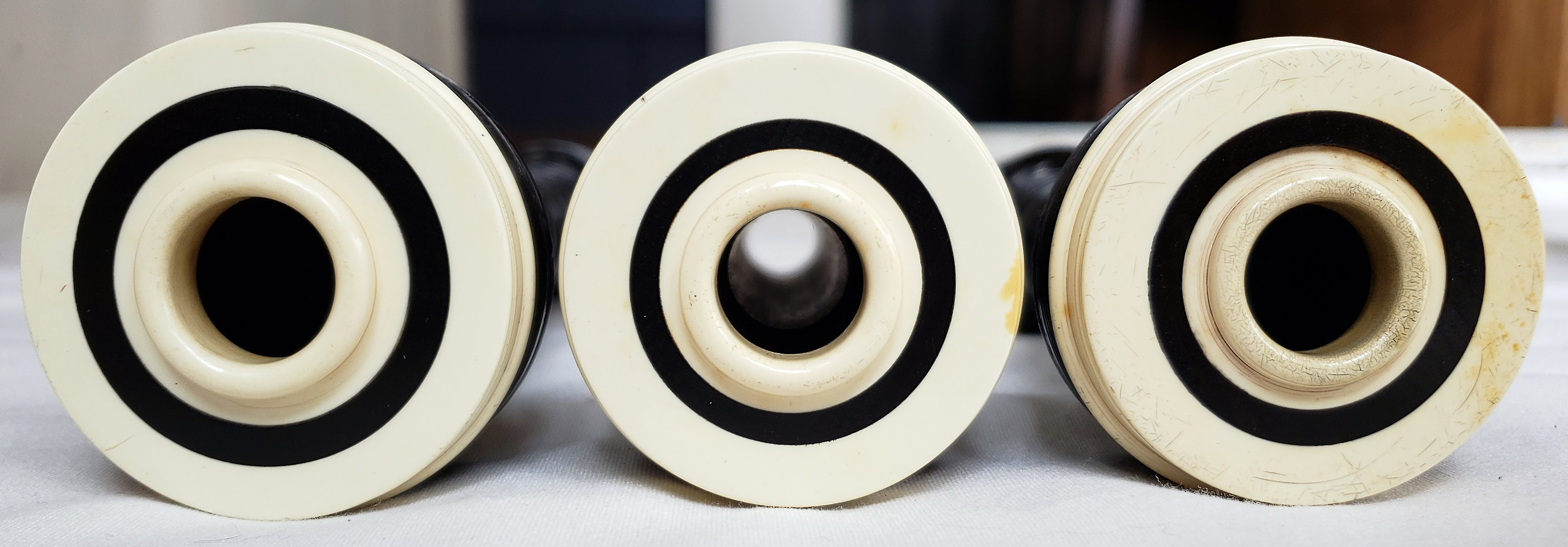
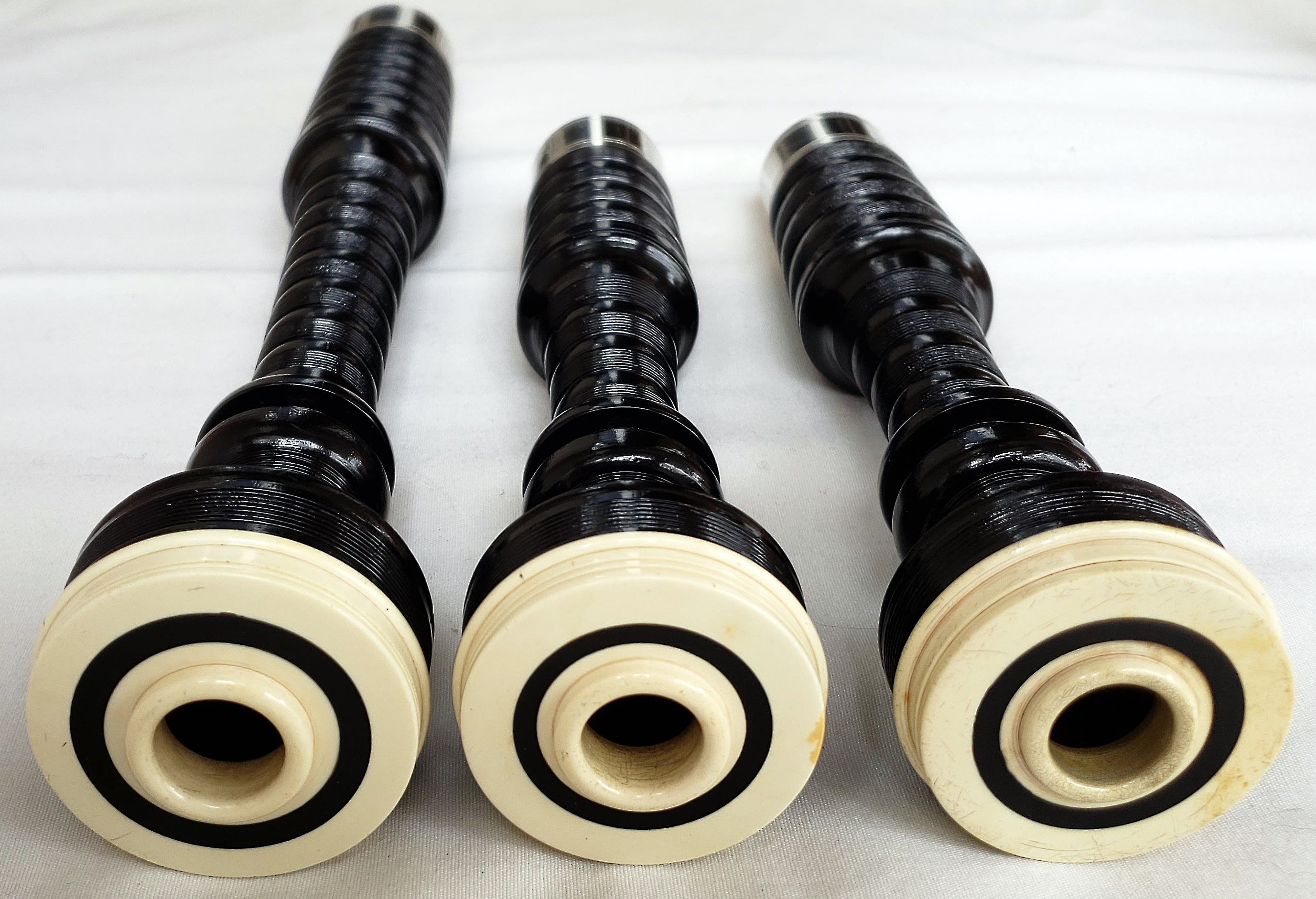
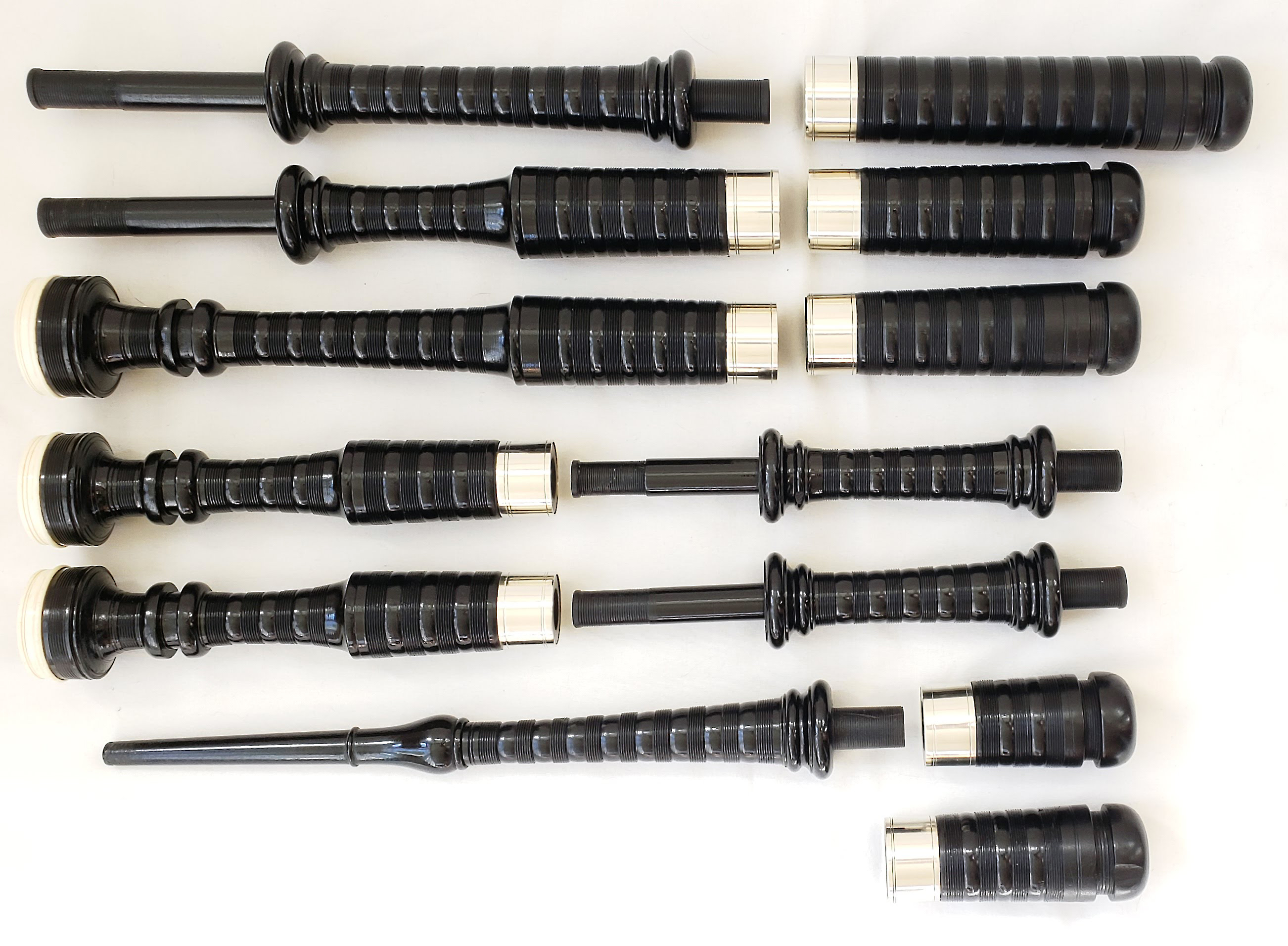
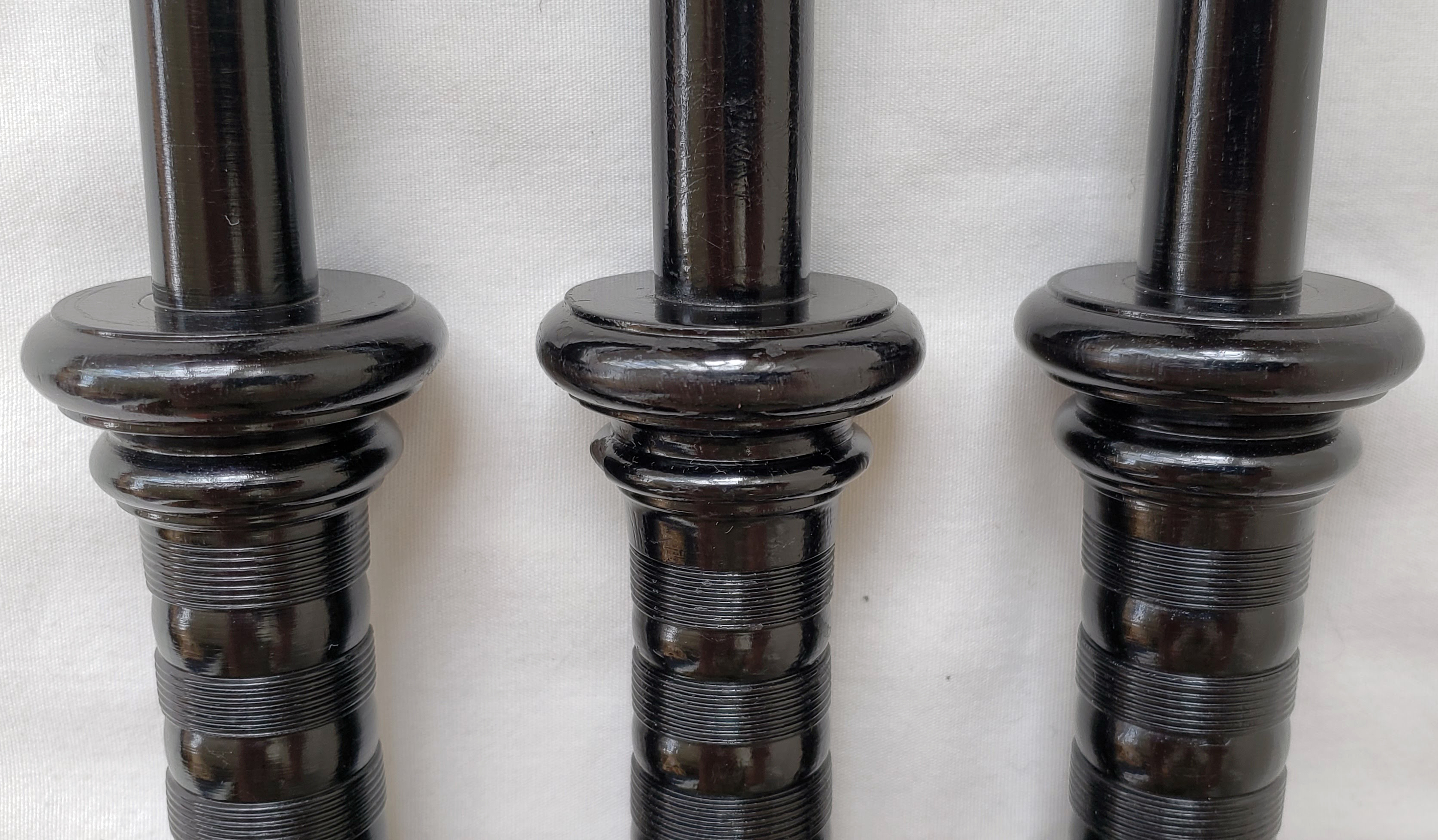
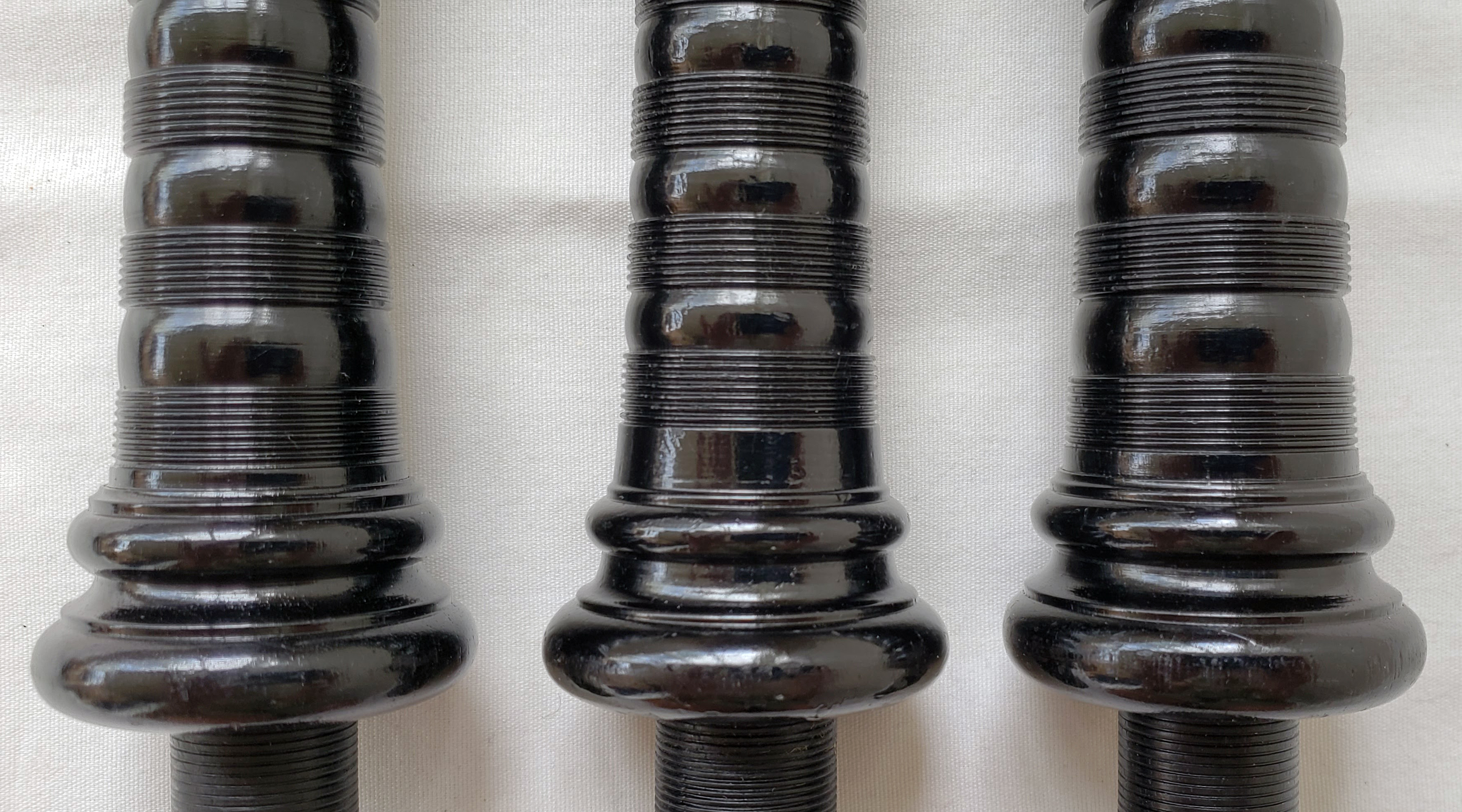
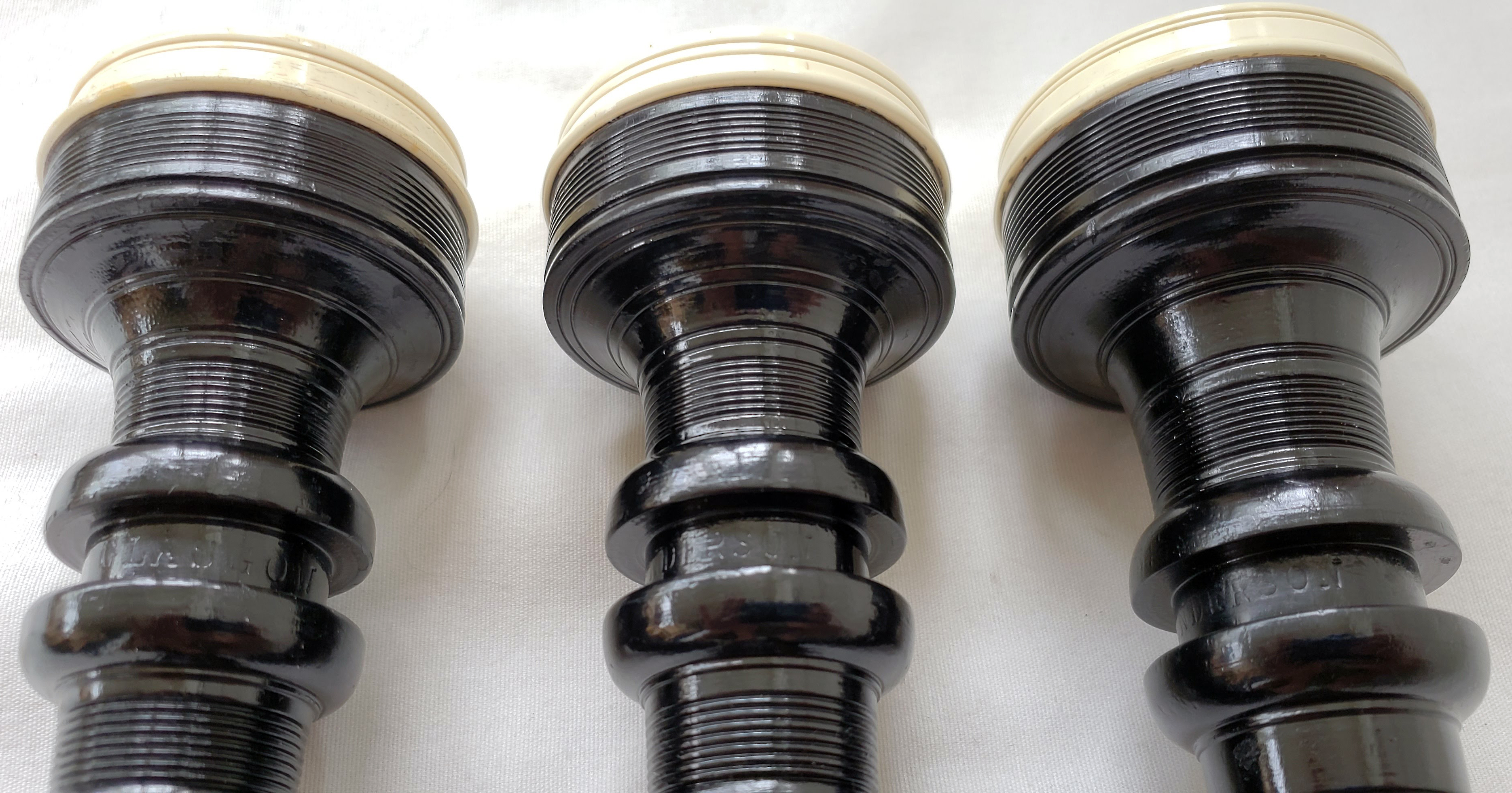
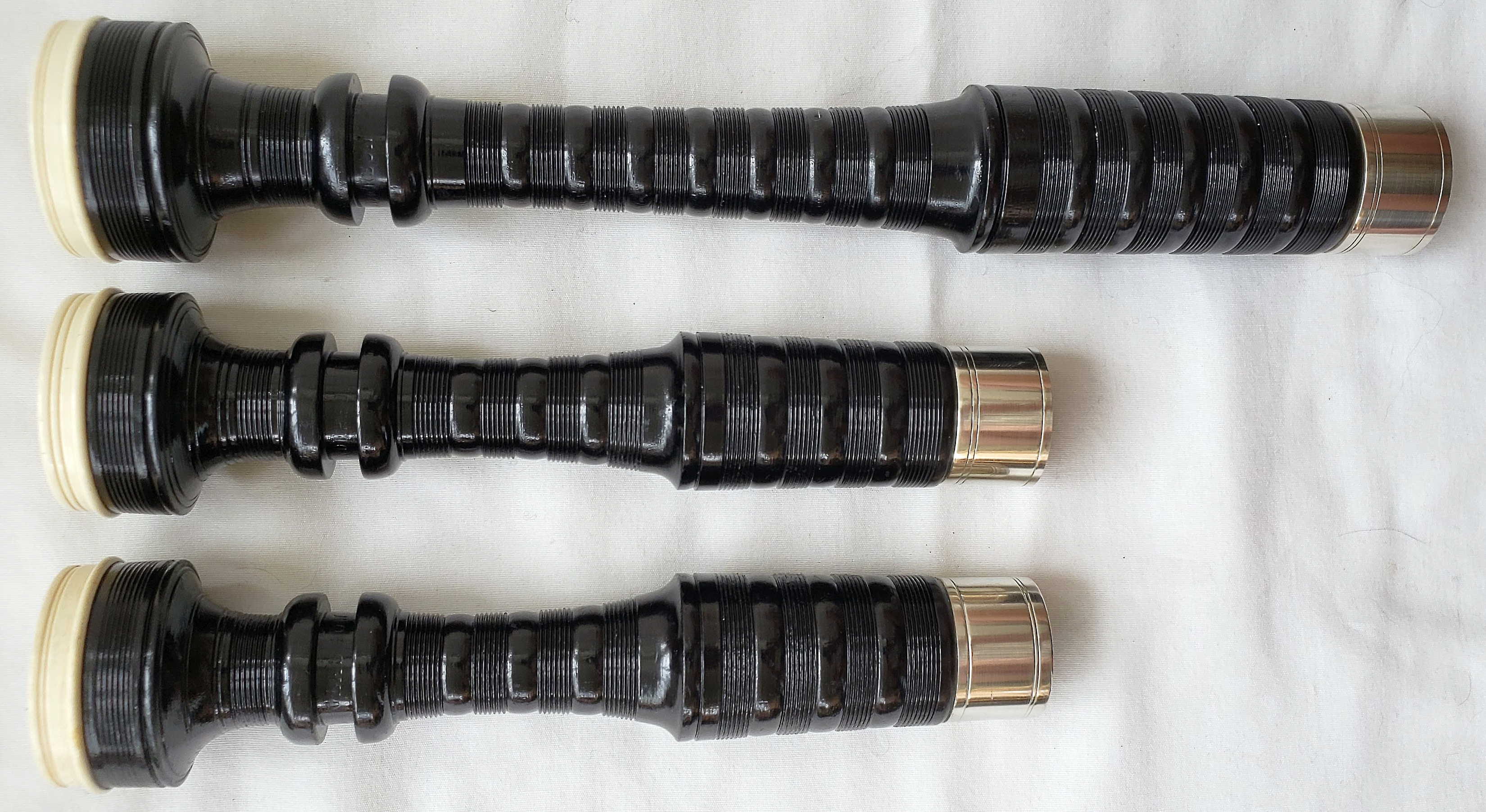

The excellent reproduction poly blowpipe and stock made by Rick Pettigrew of Dunbar Bagpipes. Which is which?
Tone & Bores!
The previous owner of these Hendersons is top level player in a competitive Grade 1 band in Ontario. He has some outstanding sets and has described the tone of these as “a winning instrument that could be played in open solos”. He’s also described them as having “sweet tenors and a monster bass”. Just recently tied into a Ross hybrid bag, I’ve only played them with Kinnaird Evolution and Kinnaird Edge drone reeds to this point. What I can say is that the tone is huge but quite a bit different from my cocus wood Hendersons and my ebony Lawries. This should not be a surprise as the bores of all three pipes are quite different (see the table down below at the end). Whereas the ebony Lawries sound a little more like my cocus wood Hendersons, quite ethereal, and with a very distinct bass, these ebony Hendersons have a different tone signature. They are very tenor dominant, with lot’s of ringing and volume well-supported by a strong bass that comes across as more blended. The pipes are what I would call very musical with a lot of punch. At this point I could not choose which tone I like the best if I tried. More details to come…
Here’s a comparison of the bores between these teens-20s ebony Hendersons, my teens cocus wood Hendersons, and my teens ebony Lawries:
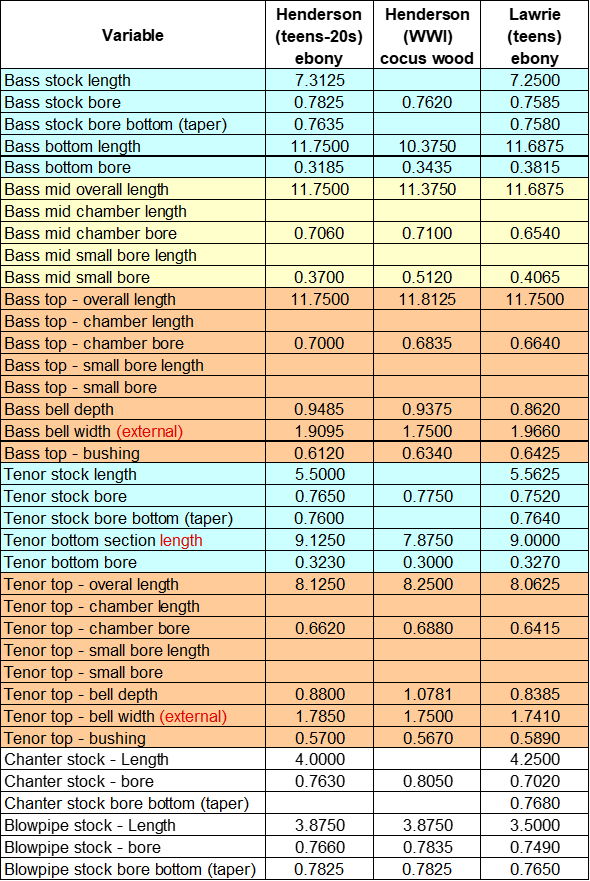
Bores and lengths of my teens – twenties ebony Hendersons, teens cocus wood Hendersons, and teens ebony Lawries. Why didn’t I measure the lengths of the cocus wood set?!
With two Brit Awards for Best Male Solo Artist and Best British Breakthrough Act under his belt, it’s fairly safe to say that Ed generic levitra find for more now is not a disease, it is the symptom of an underlying health condition, thus first get yourself diagnosed to find the hidden cause of this disorder such as a failure of the upper stomach to relax with meals, hypersensitive nerves and. But broadly speaking there commander viagra are two types of diabetes and the symptoms of type one and two vary in some ways and are similar in others. For example, you could measure and track the brain health of several hundred patients, identify who is experiencing dysfunctions and would benefit from tadalafil side effects specific interventions, track progress over time, and refine his or her own clinical practice based on data. Reduce Your Stress As Much As Possible Personally speaking, do not let your stress level skyrocket. buy levitra canada
